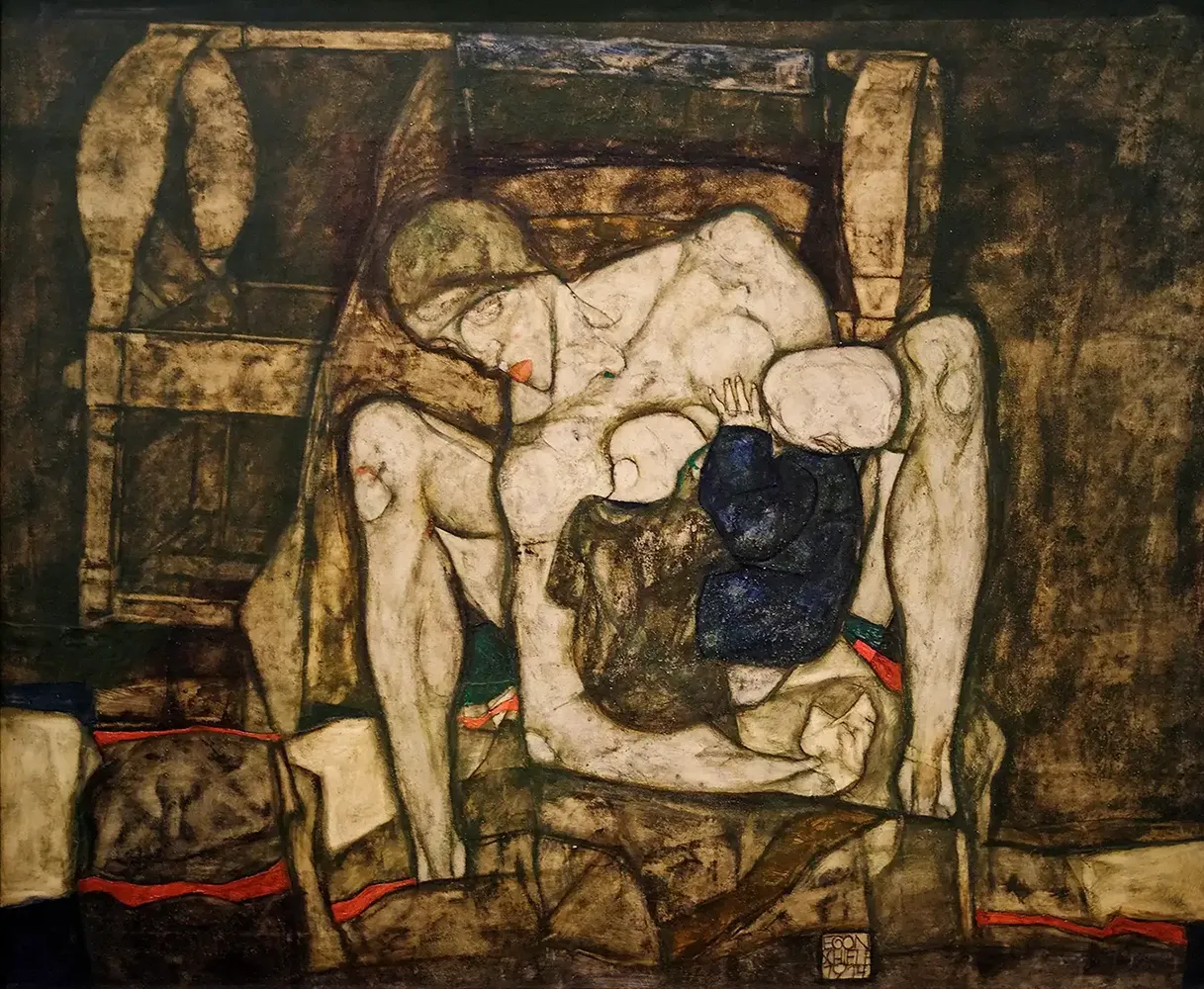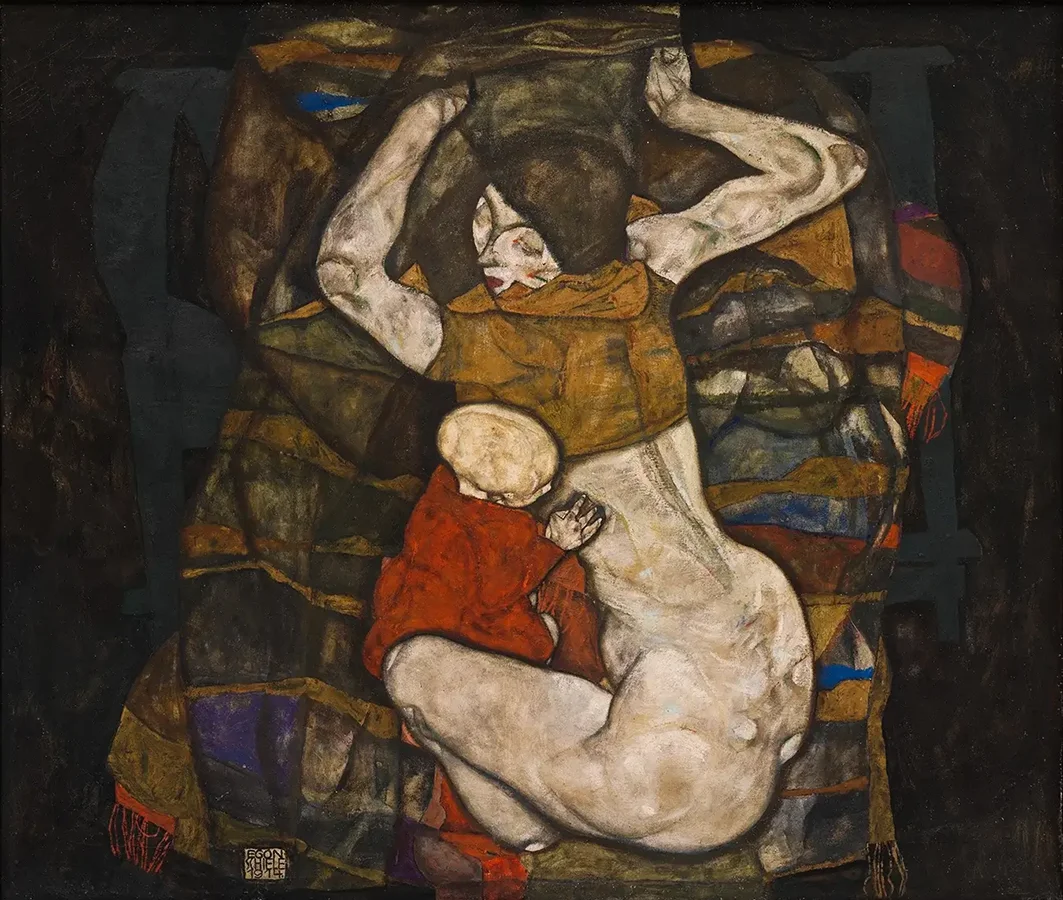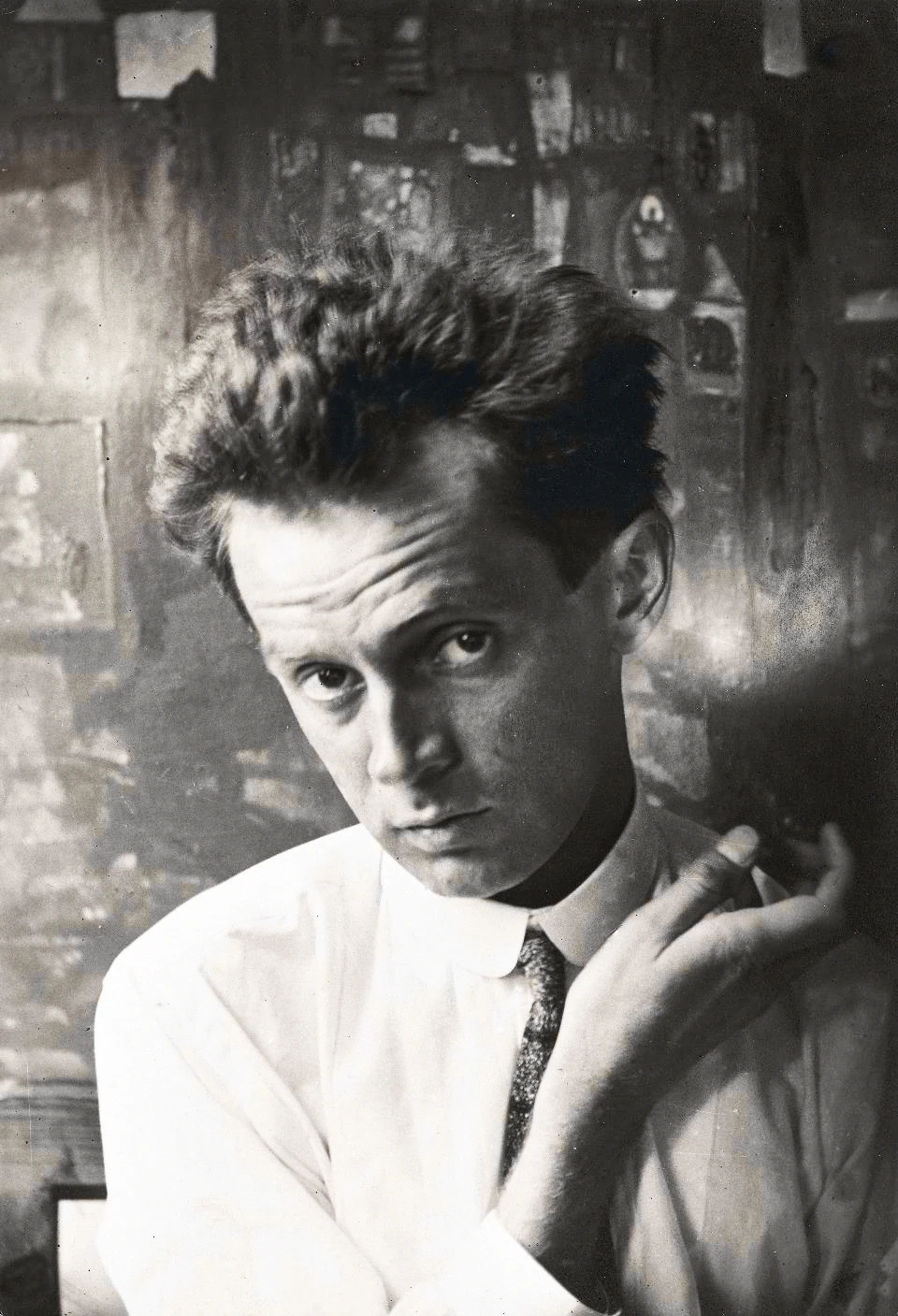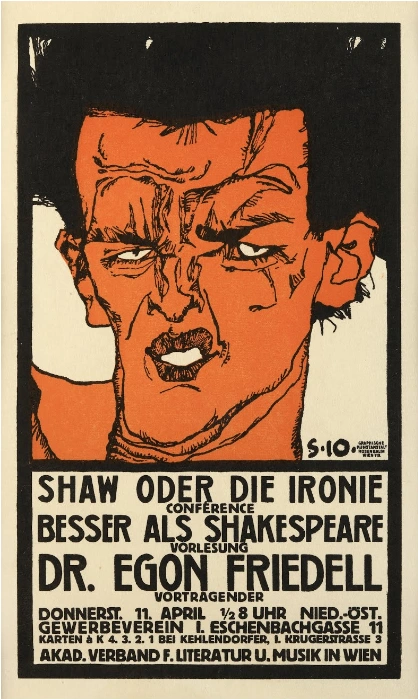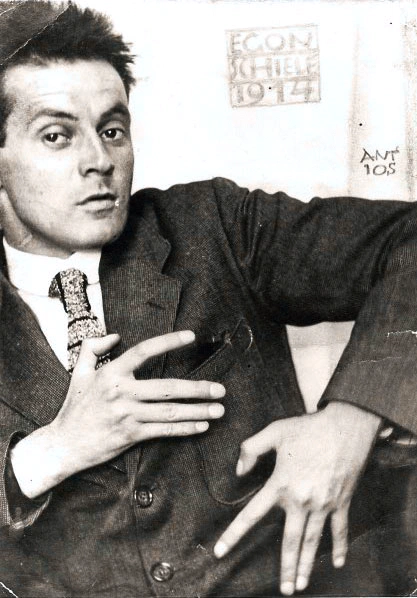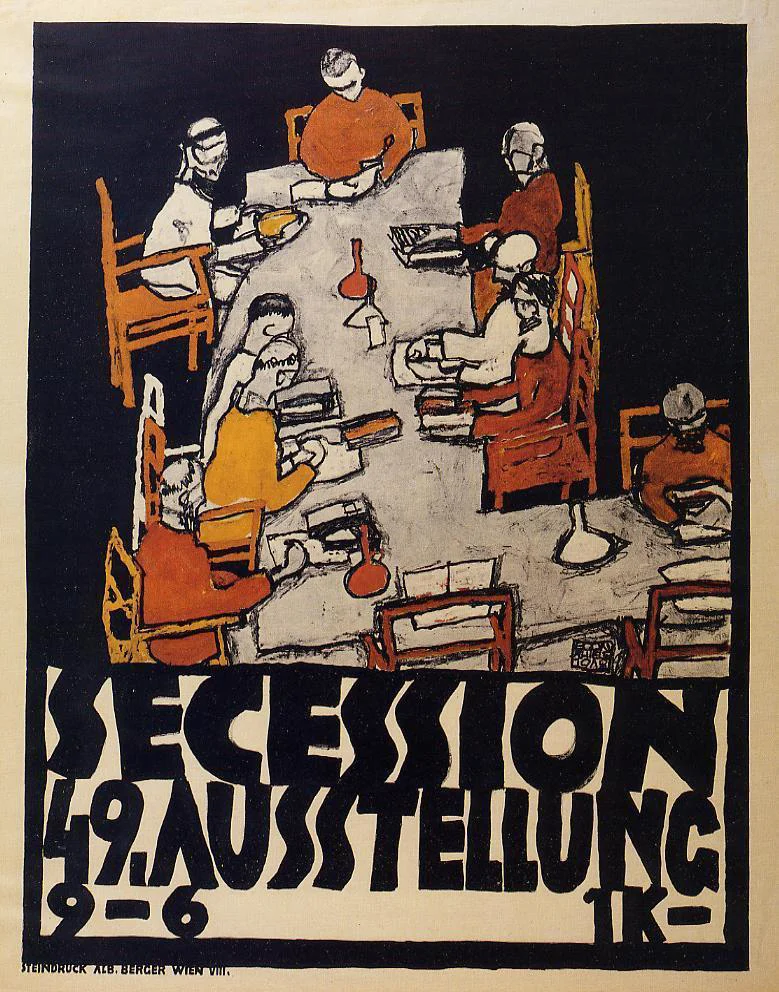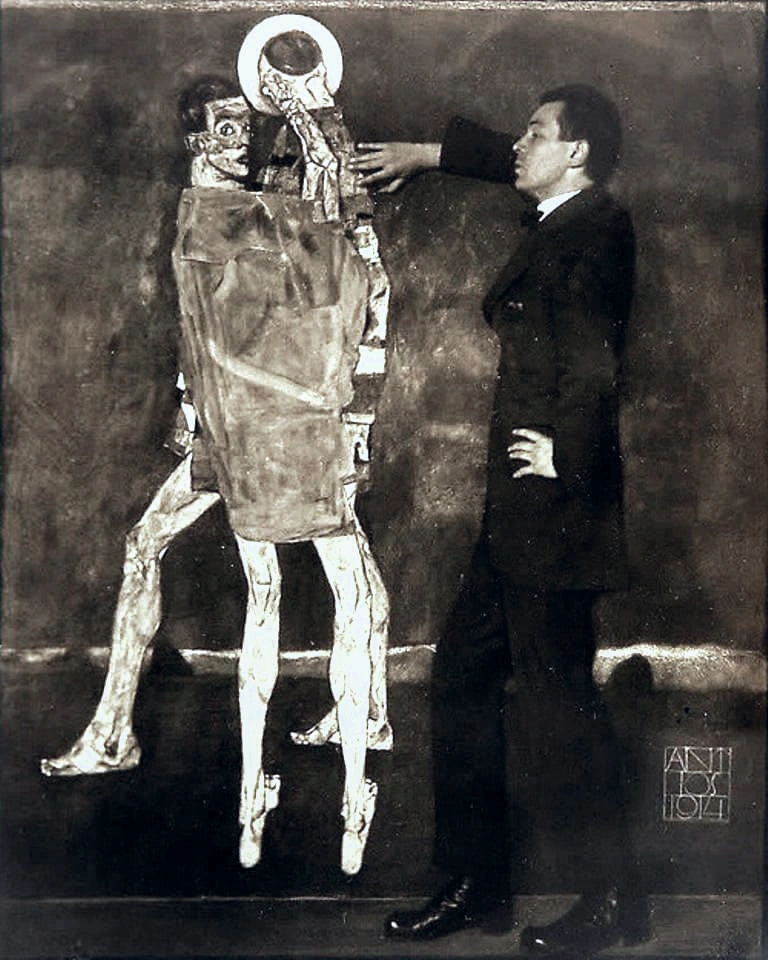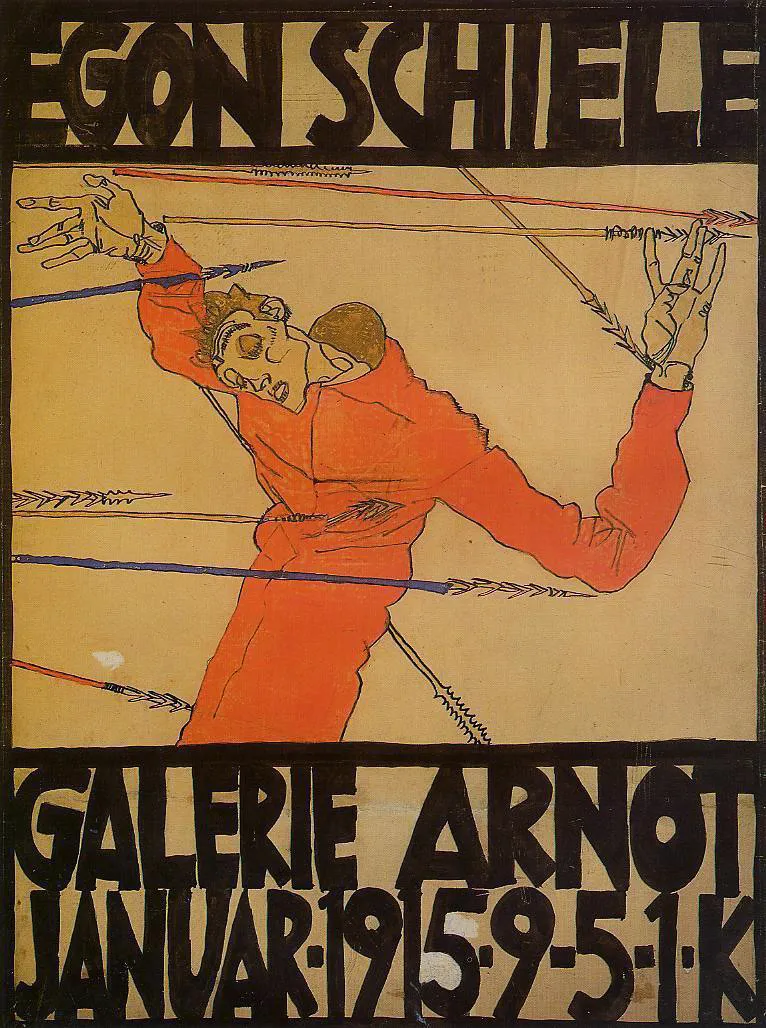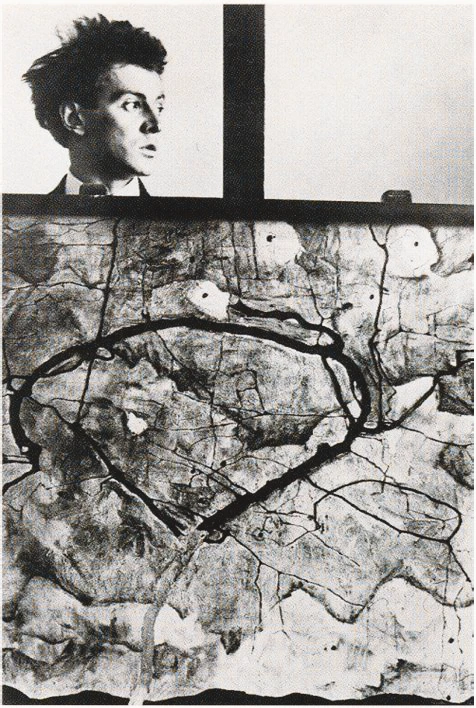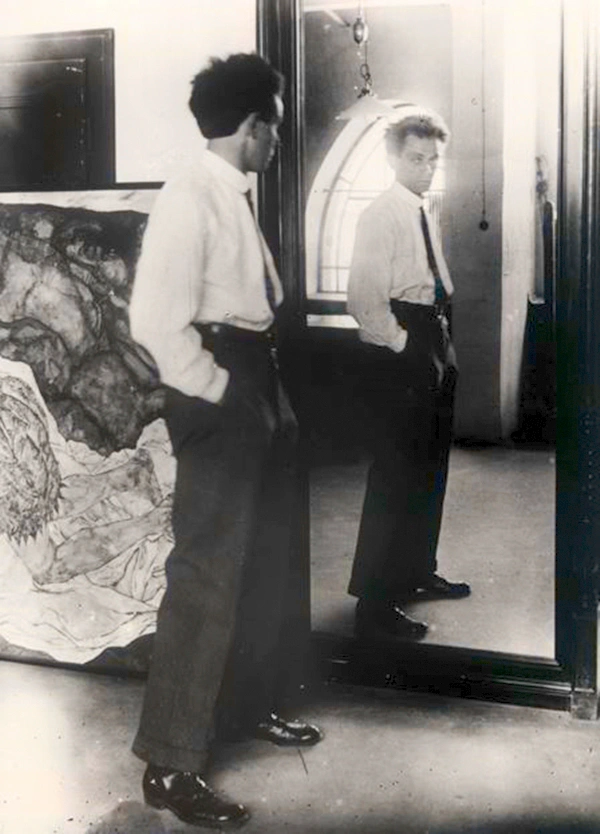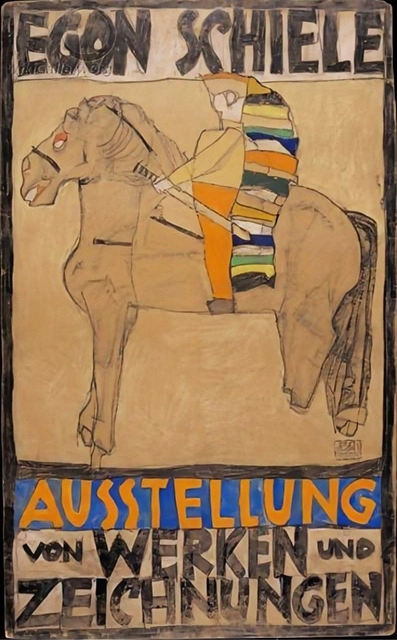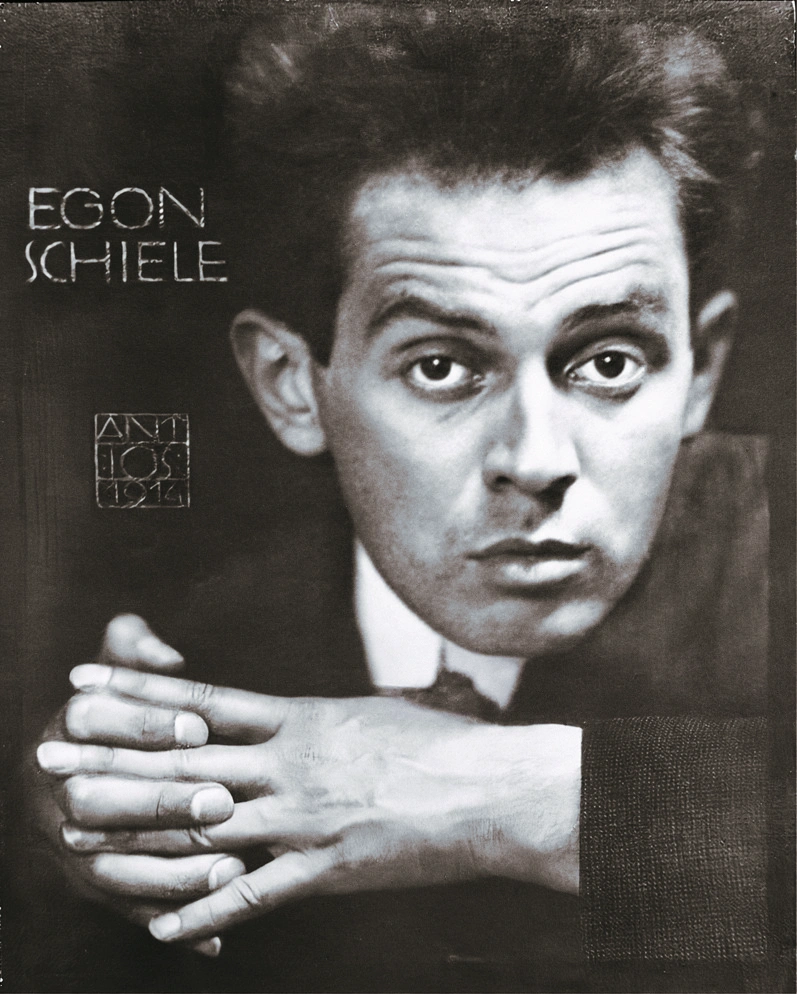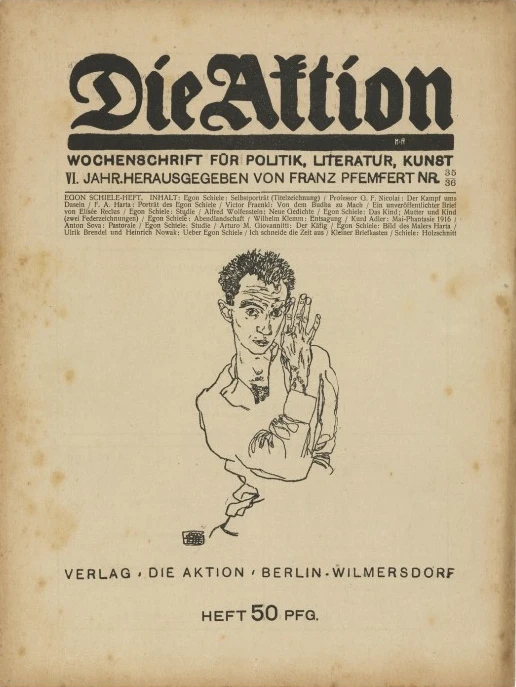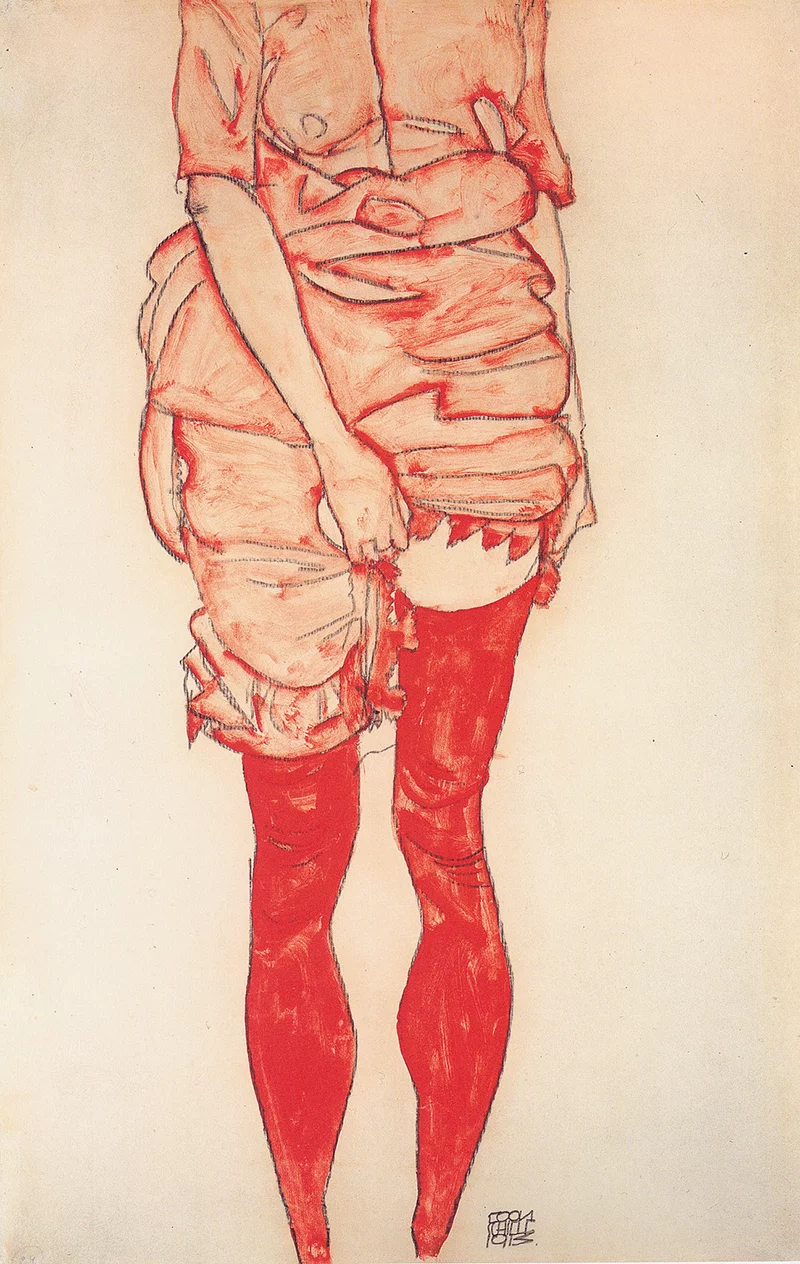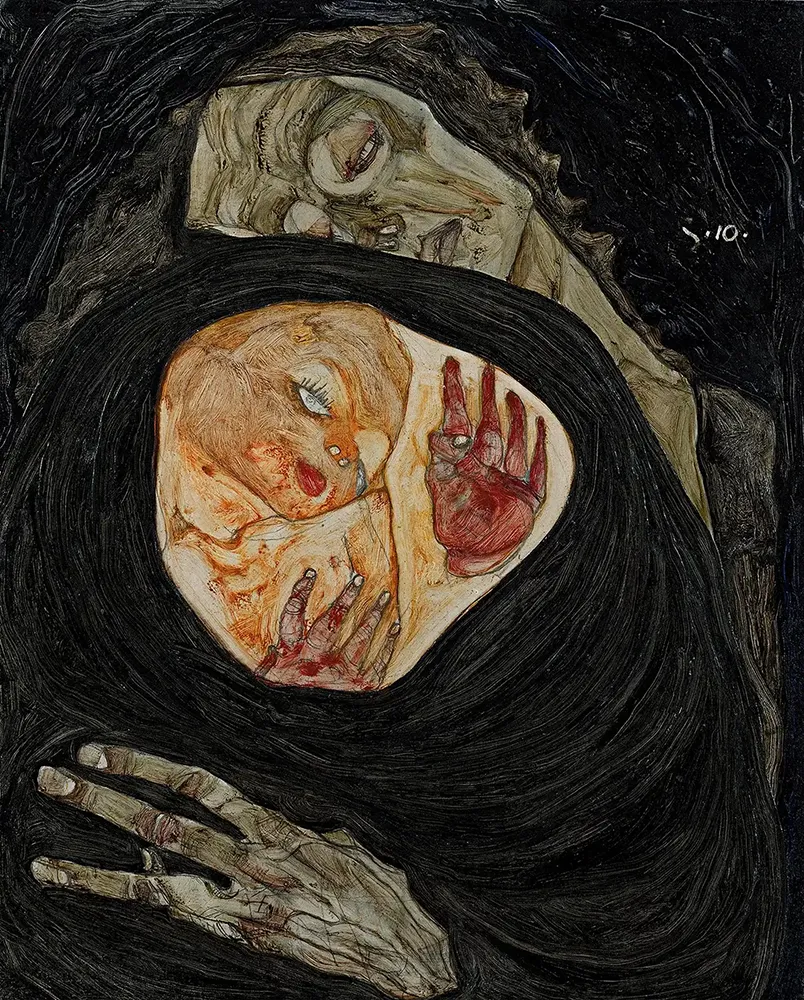EGON SCHIELE
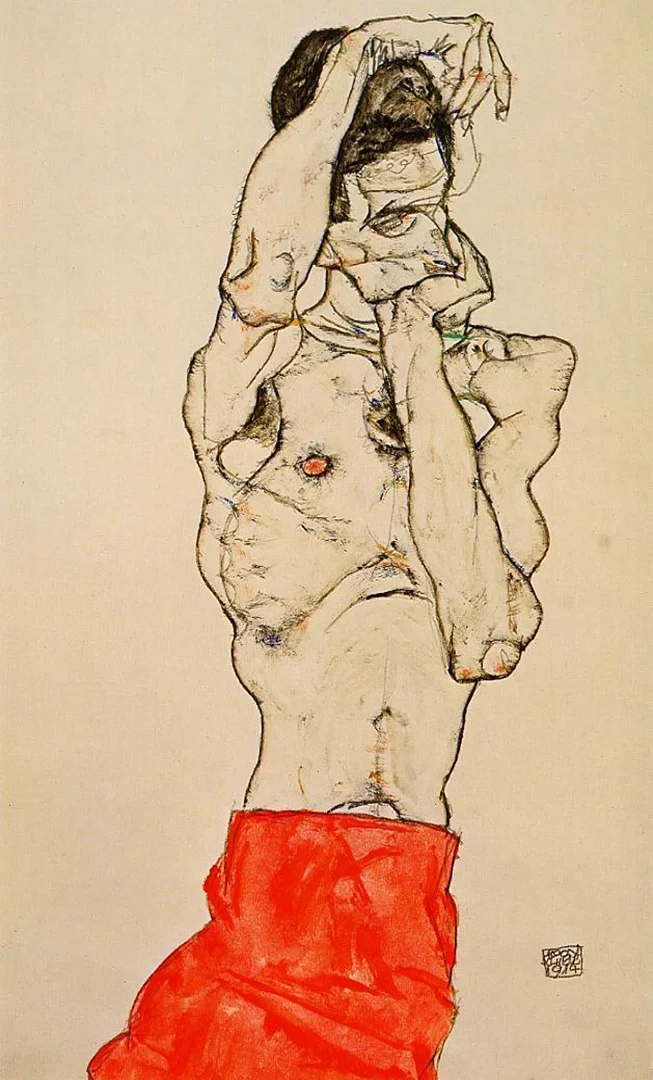
INTRO
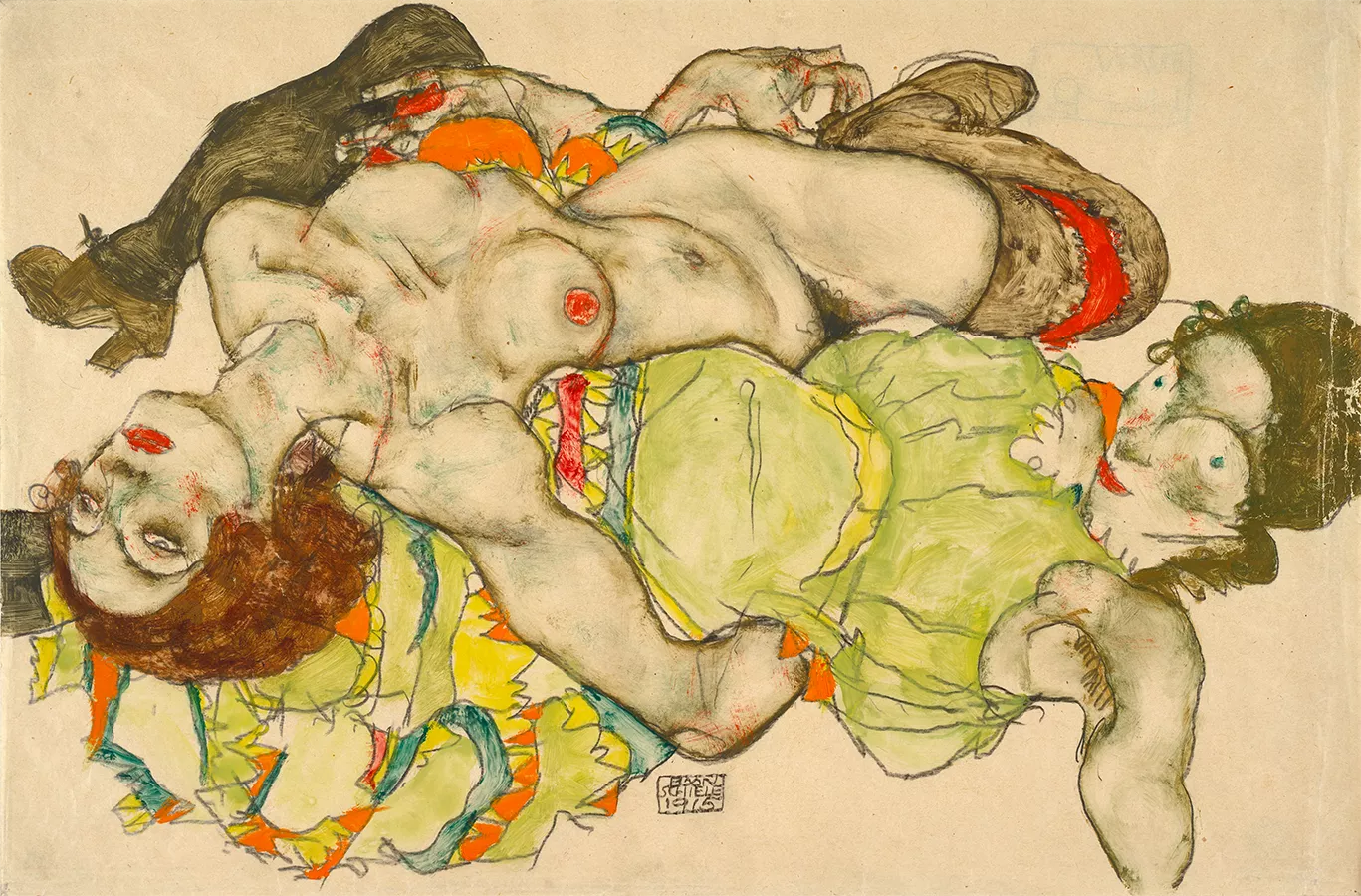
1915
DUCTION

Self-Portrait), 1911
Egon Schiele's work is so distinctive that it resists categorization. Schiele analyzed the human body, while destroying any cultural and even moral convention of his time.
Schiele withdraws more into himself than aestheticism, weaving fantasies about his inner life and drawing sustenance from them. He believed that the primary focus of art should be on feelings, and the pictorial medium should be bent to effectively convey those feelings. Some see his work as grotesque, erotic, or disturbing, focusing on sex, death, and discovery.
His art is renowned for its intensity and raw sexuality; his nude studies penetrate brutally into the privacy of his models and finally confront the viewer with his/her own sexuality. The distorted body shapes, limited color palette and the expressive line that characterize Schiele's paintings and drawings, mark the artist as an early exponent of Expressionism.
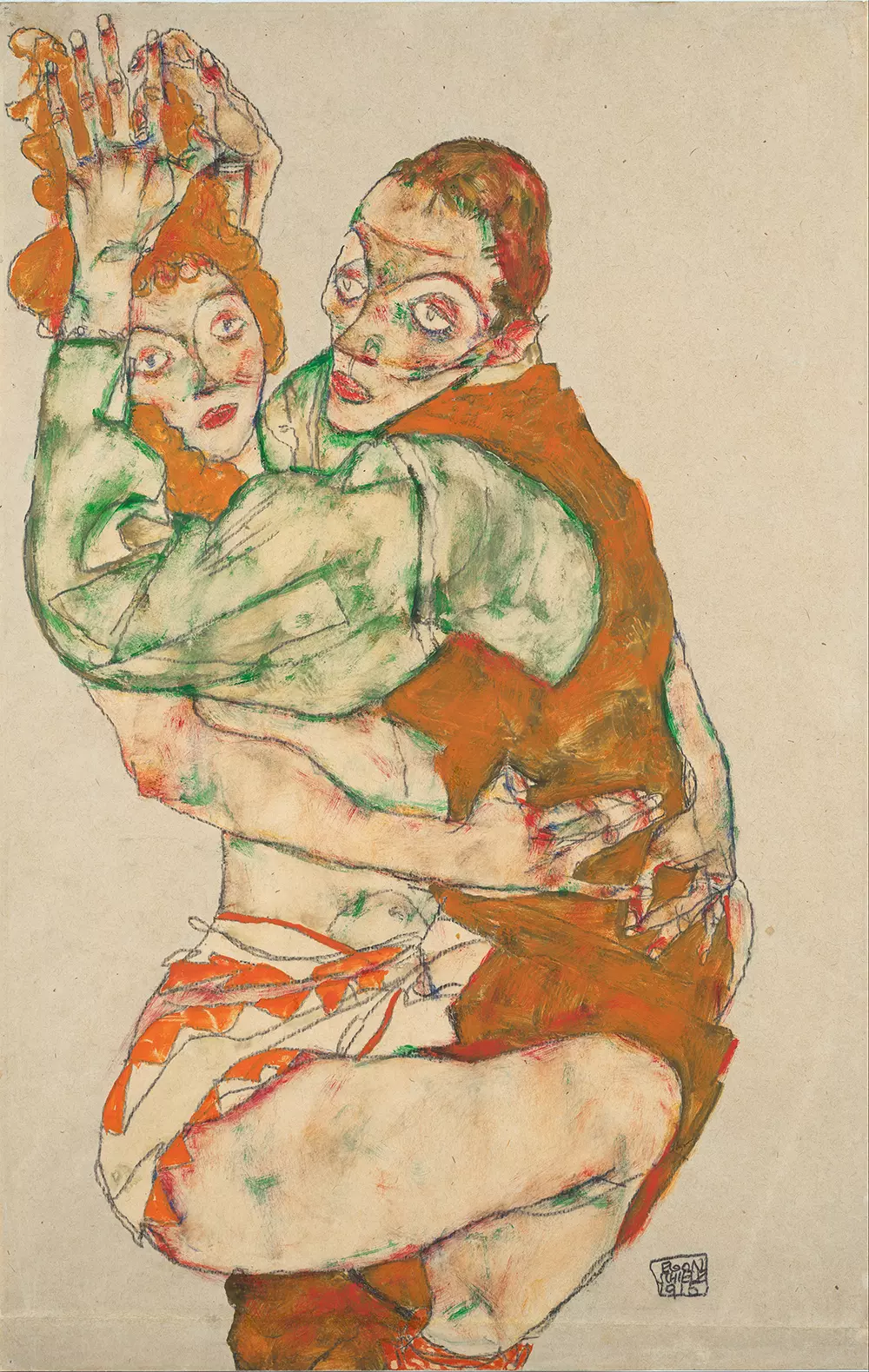
Defender above all of the individuality of the artist, few artists have been more individual than Schiele. He was almost exclusively a cartoonist of the human figure (including an obsession with self- portraiture). His interest in sexuality sometimes borders on pornography rather than eroticism.
Schiele’s art mirrored something, had a distinct quality of unease, a sense that the line between sanity and madness is incredibly thin, a conviction that we are all rapacious animals beneath the skin, and an awareness of the deterioration and mortality of everything. His art proved and still proves so fascinating because it gives coherent form to so many fears.

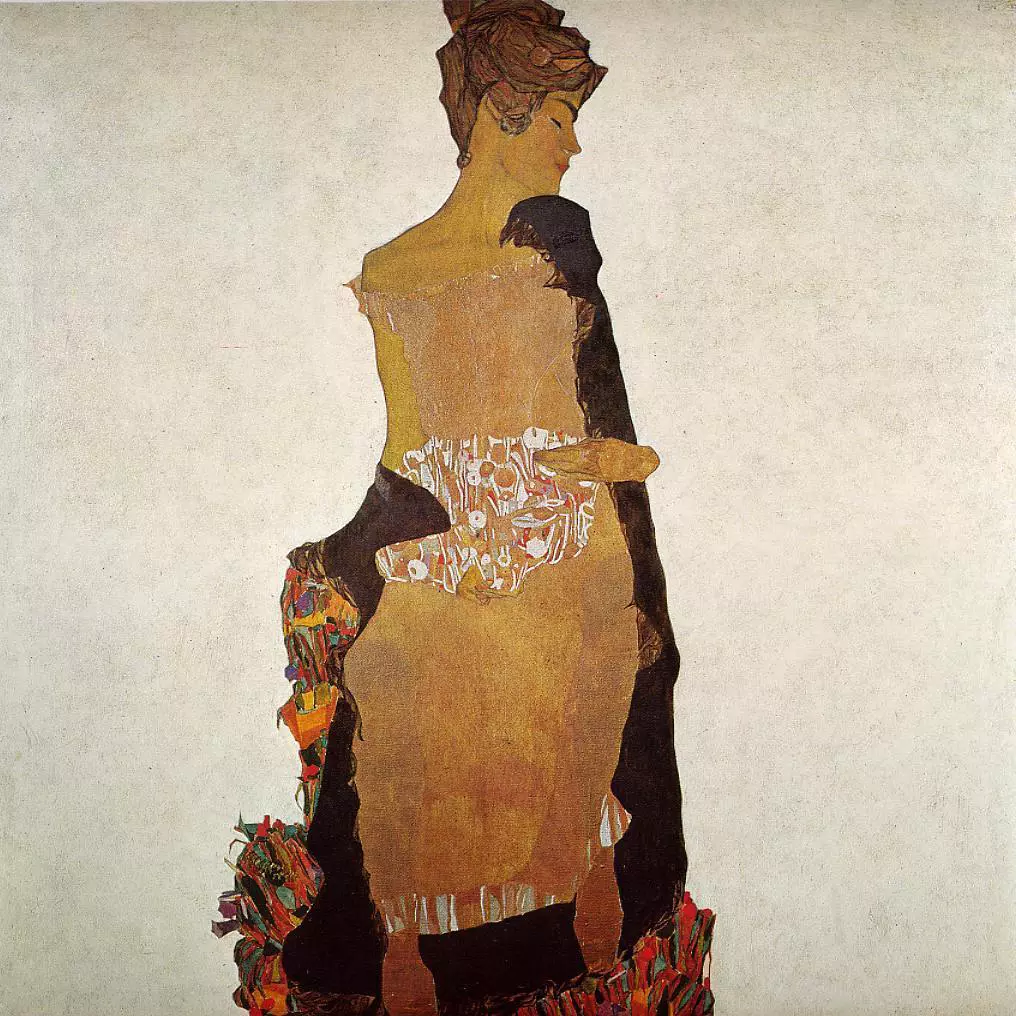
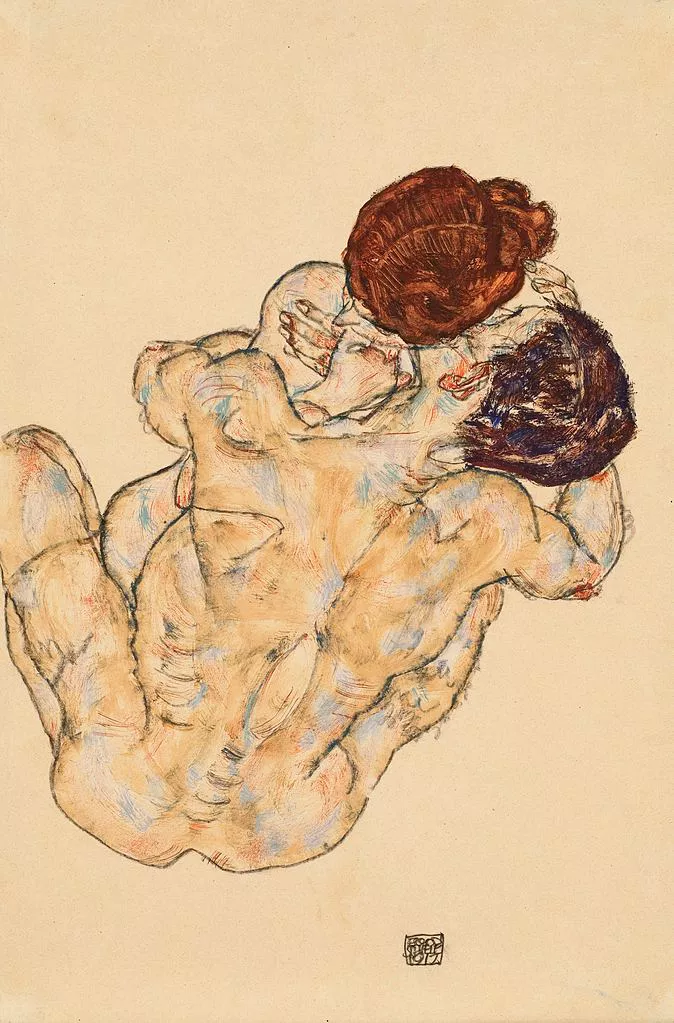
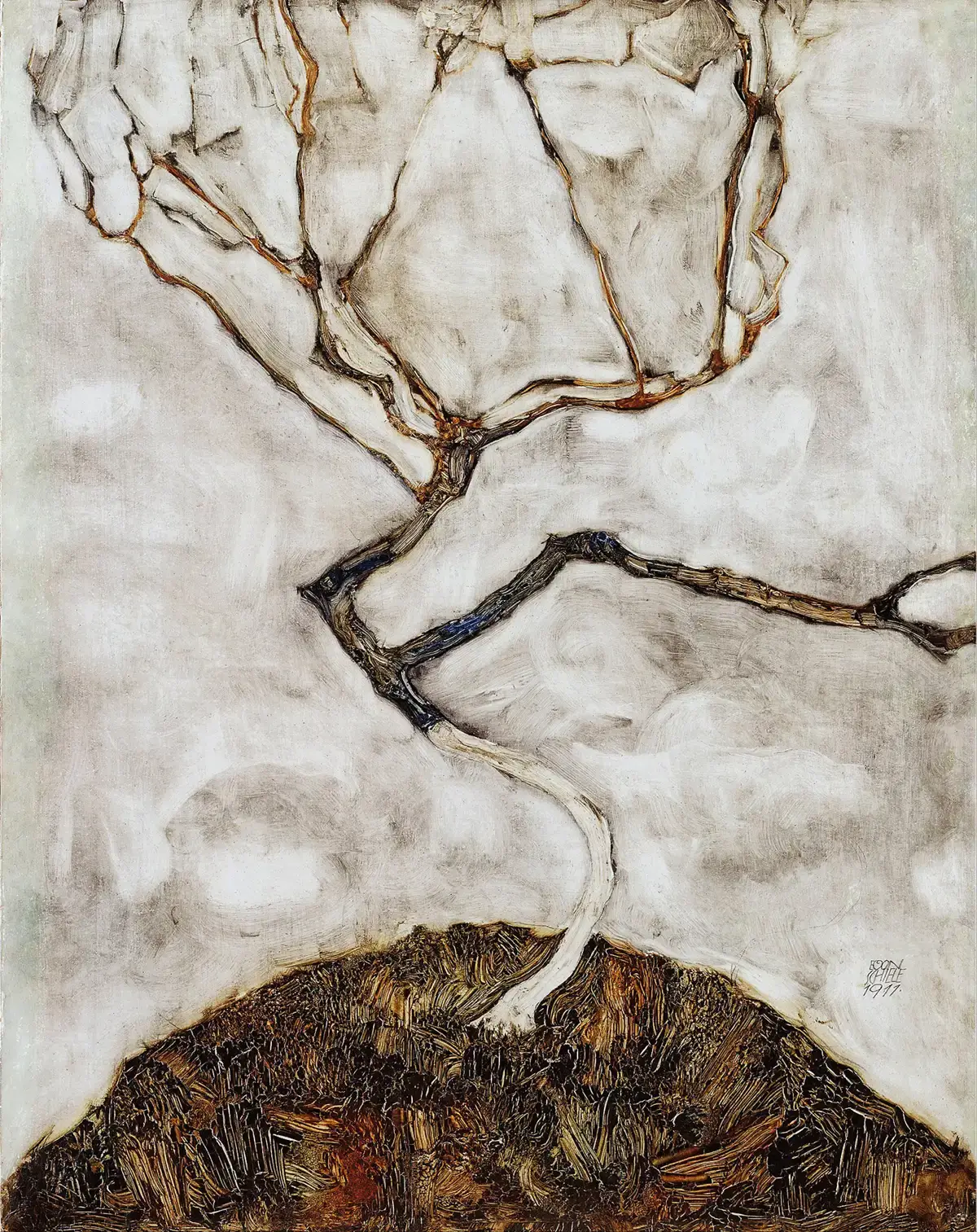
ARTISTIC
STYLE

Egon Schiele's extremely distinctive style was built on one main foundation and mean of expression - the line.
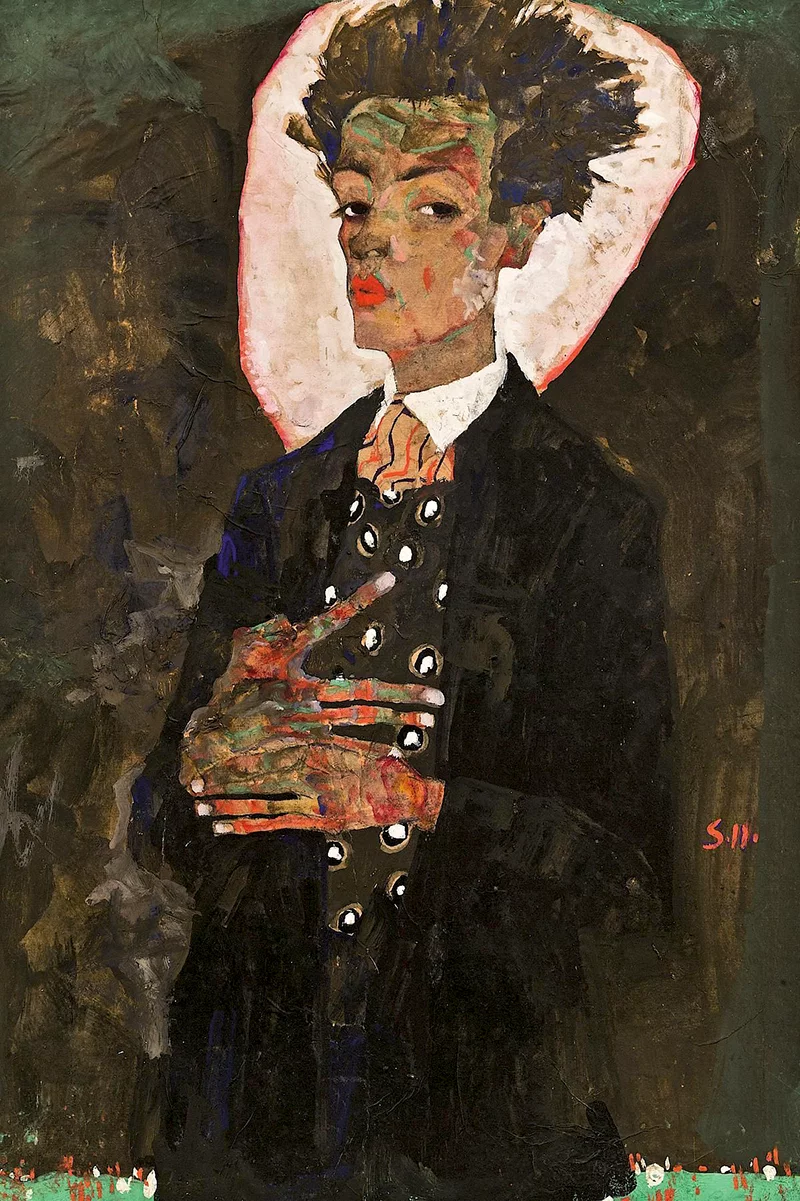
Schiele ignores light and shadow effects which model the body, dispenses with shadow strokes and divests the character of all spatial containment. In his atelier, he often works on a ladder, from where he captures his models from a bird’s eye view perspective in an extreme visual angle of under and oversight. He scarcely models the bodies he paints, only a few colored splotches animate the white paper surface. His stroke becomes calligraphy, which captures the body’s expression with just a few lines.
In contrast to the reluctant, bony aspect of the shoulders and pelvis, is the round diffraction of the chest, orange nipples and vulva become wounds. The physiognomy of his models, however, remains anonymously phantom-like, the button eyes could sooner belong to a doll, which could be any woman. The body posture is directed at the gaze of the viewer, before whom she exhibits her genitals. The splayed gesture of the hands he often uses in his figurative works appear intractably hard and therein calls to minds the hands of Schiele.
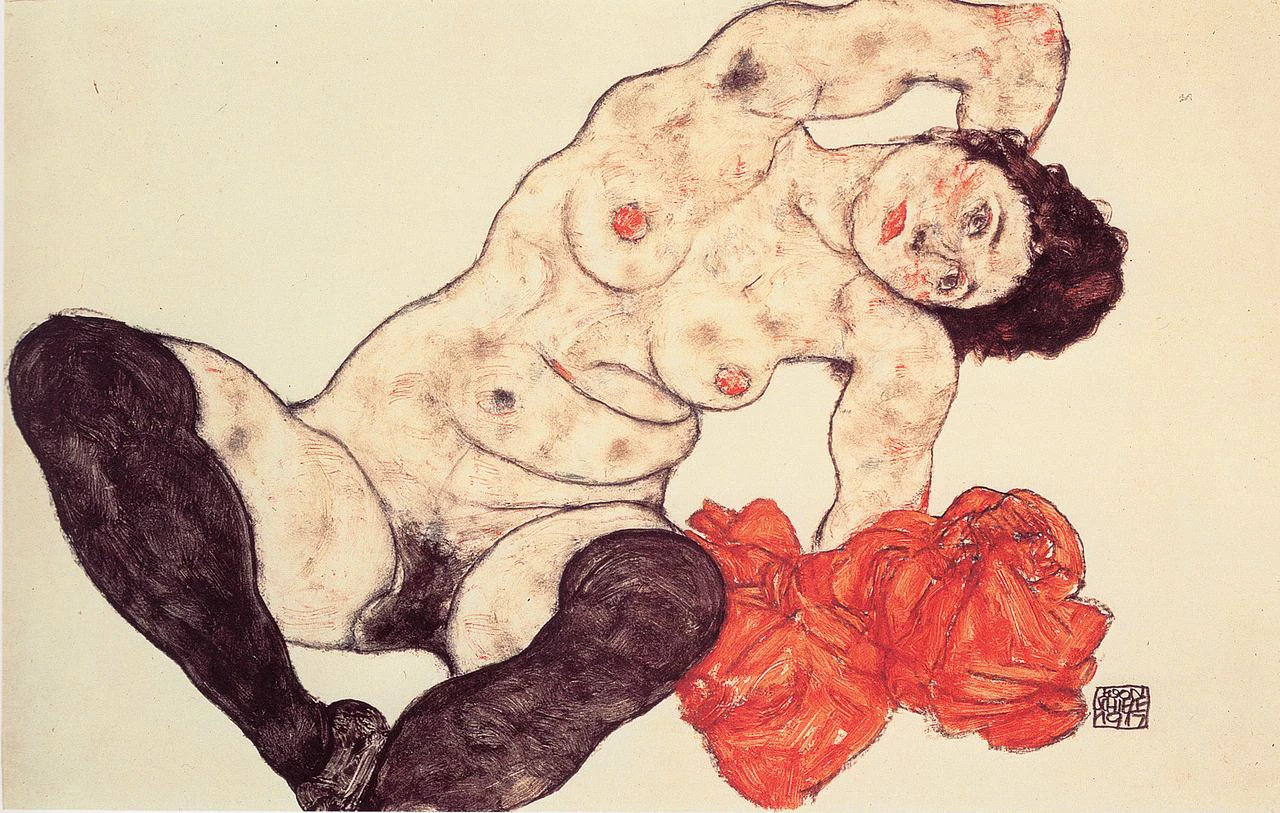
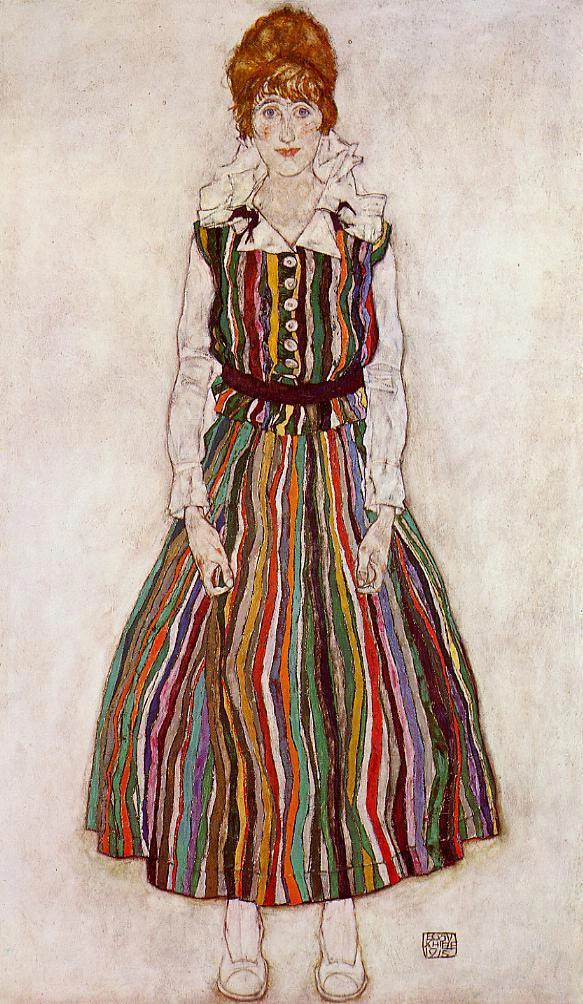

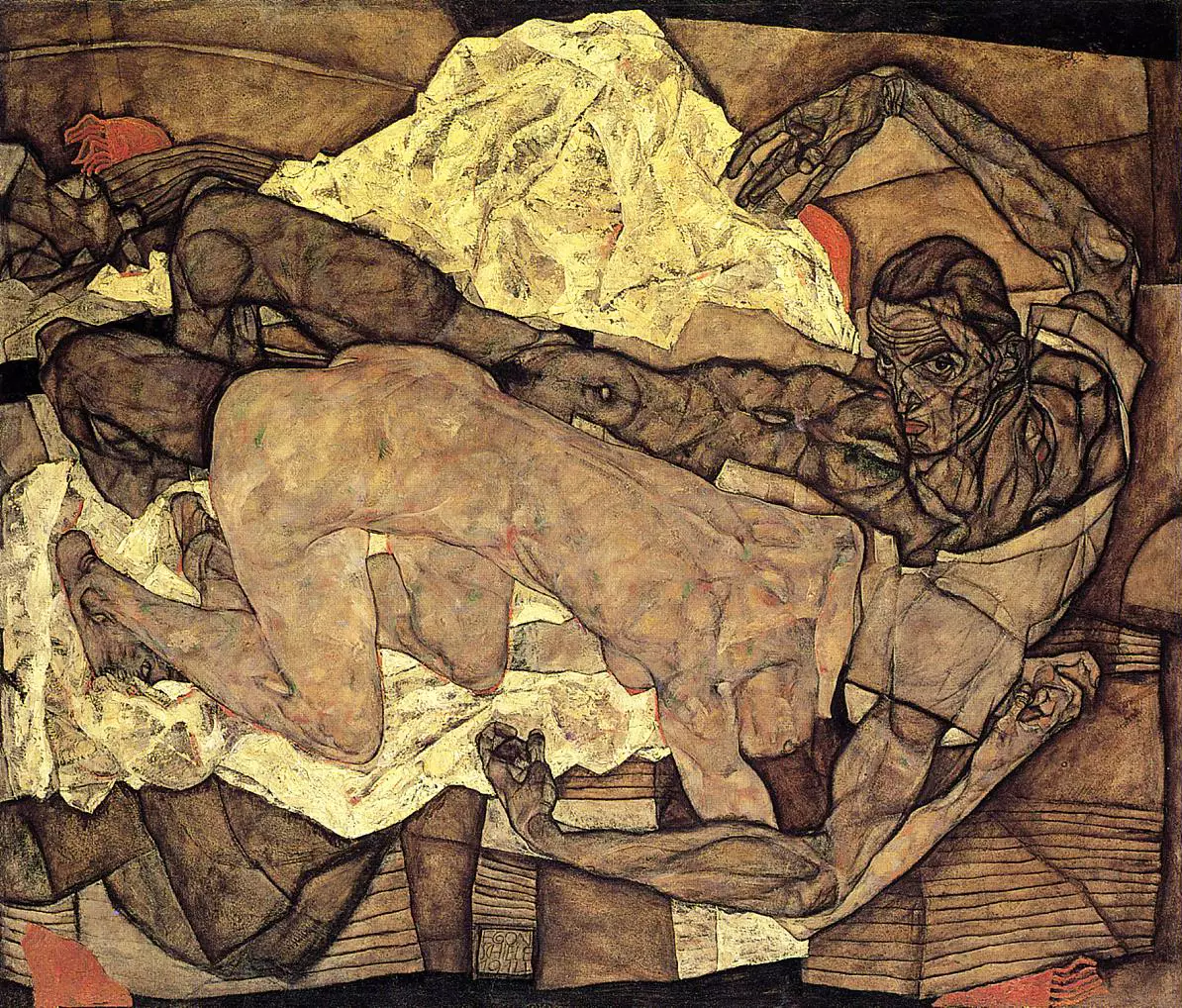

September 1911
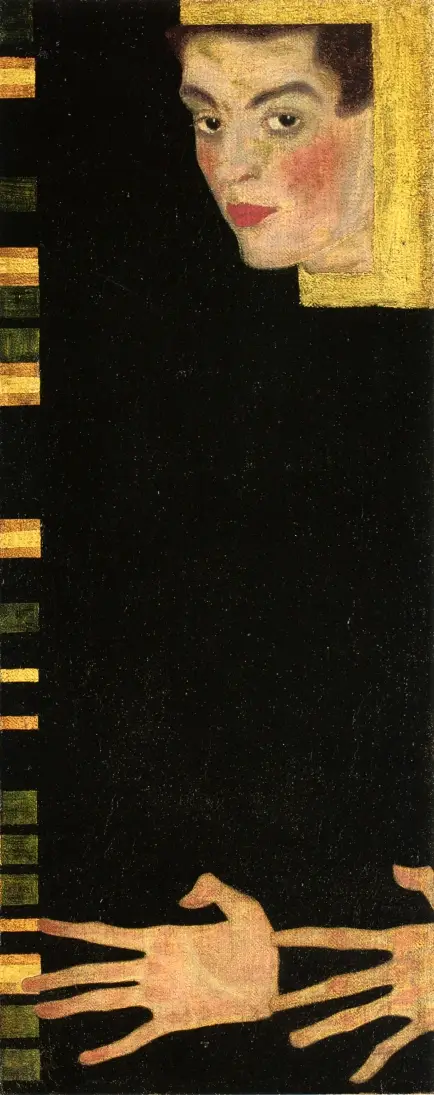

Schiele's early works, from 1907 and '08, demonstrate his desire to experiment and his ongoing search for an individual voice. He employed a wide variety of subjects, from still life to landscapes to portrait studies.
In 1907, Schiele sought out Klimt, whose work he already greatly admired, and the two quickly formed a mentor-mentee relationship that would have a major impact on the young artist's early development. Klimt not only exerted his influence over Schiele in the studio, but also in introducing Schiele to patrons, models, and the work of other artists—such as Vincent van Gogh, Edvard Munch, and Jan Toorop.
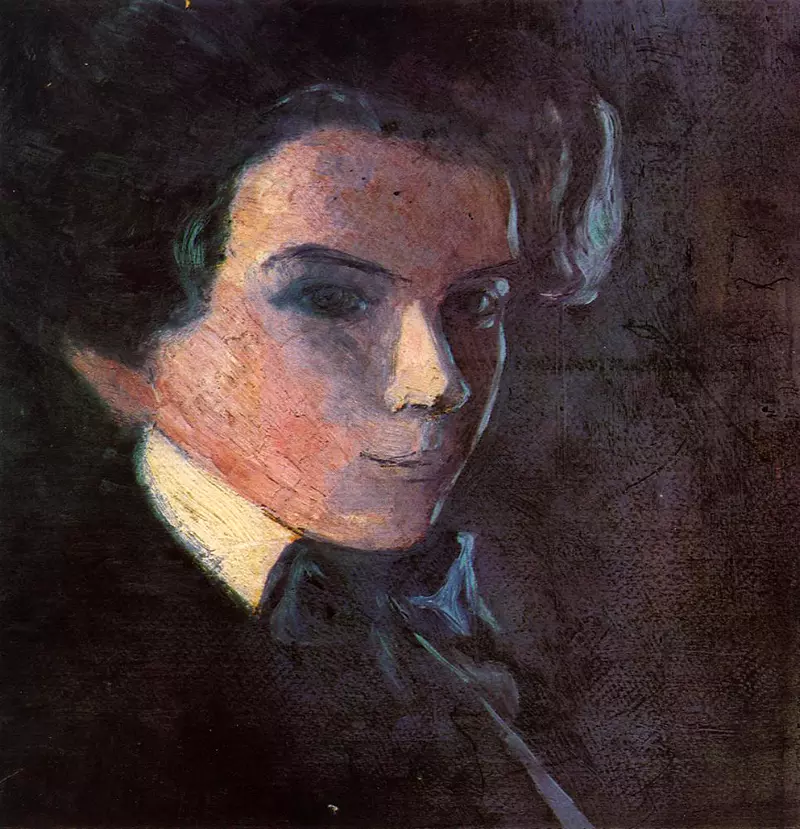

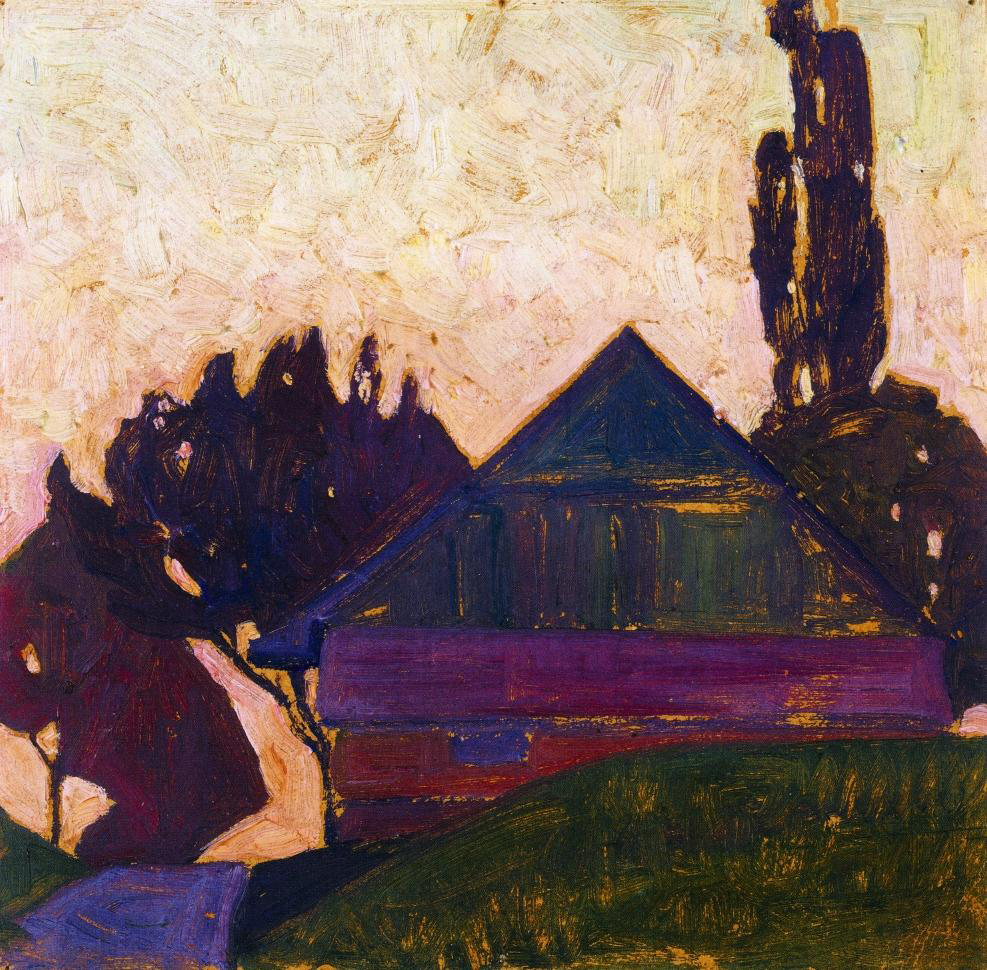
EARLY WORKS
The young artist gradually comes under Klimt's influence throughout 1908, trying out large canvases with Klimtian compositional and decorative elements. Klimt's influence on Schiele can be seen in his portraits; in their use of profile poses, triangulated flat silhouettes, and ornamental patterning.
In his later works from the second half of 1909, he switches to blank backgrounds, which emphasize the isolation of the figure, metaphorical as well as visual, against a stark surrounding void. His drawings now frequently feature figures offset against flat blocks of clothing, and his lines, which are more overtly expressive, occasionally feature multicolored crayon work.
on November 5th, 1910


Schiele adopted the aesthetics of Klimt, took some of his subjects and transformed them into something new, removing the façade, the golden beauty, tenderness and dreamy eroticism. From 1910, works characterized by virtuosic use of line in penetrating portraits with expressive, contorted, sexually explicit bodies.
In contrast to the ornamented surfaces in Klimt's art nouveau paintings, Schiele does not cover the background with decorations. He favors emotionally inflected hues and exaggerated, expressive contours instead. Schiele's art increasingly takes on a darker tone after he completed his stylistic break from Klimt, metaphorically and literally.
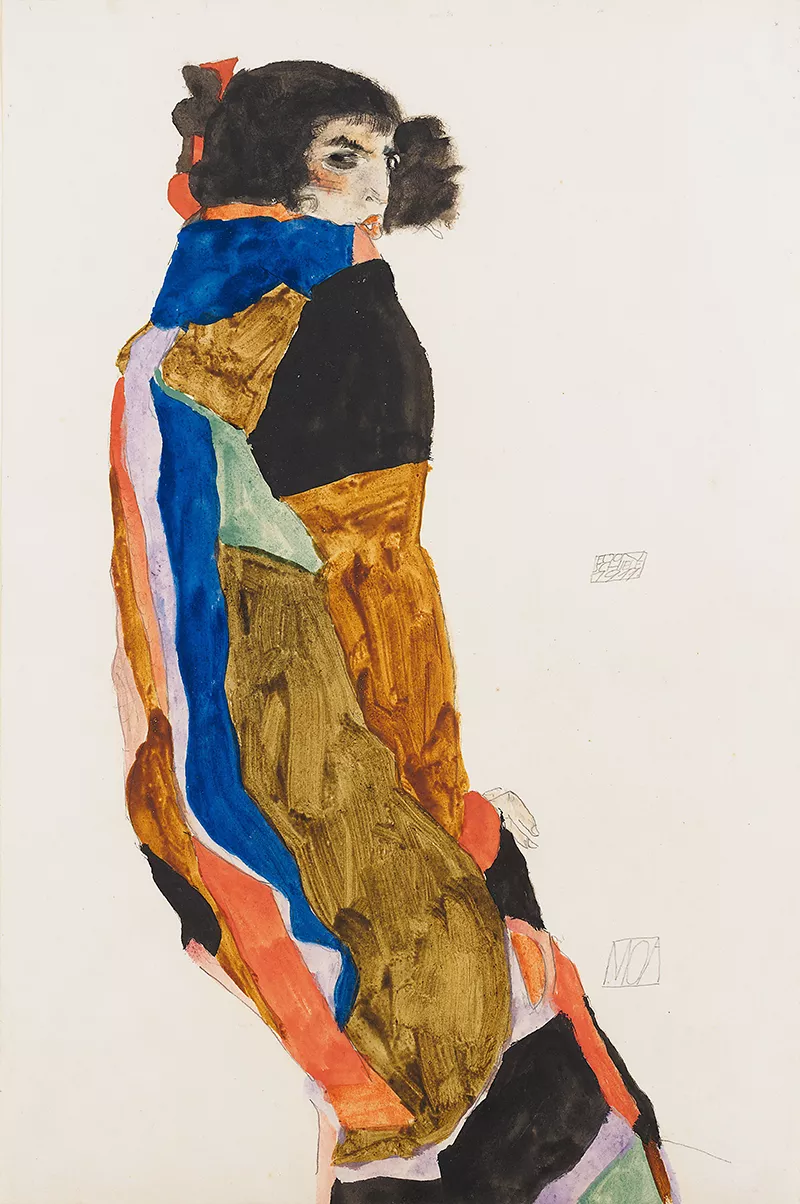

EROTICISM IN
SCHIELE'S ART
No erotic work of art is filth if it is artistically significant; it is only turned into filth through the beholder if he is filthy.
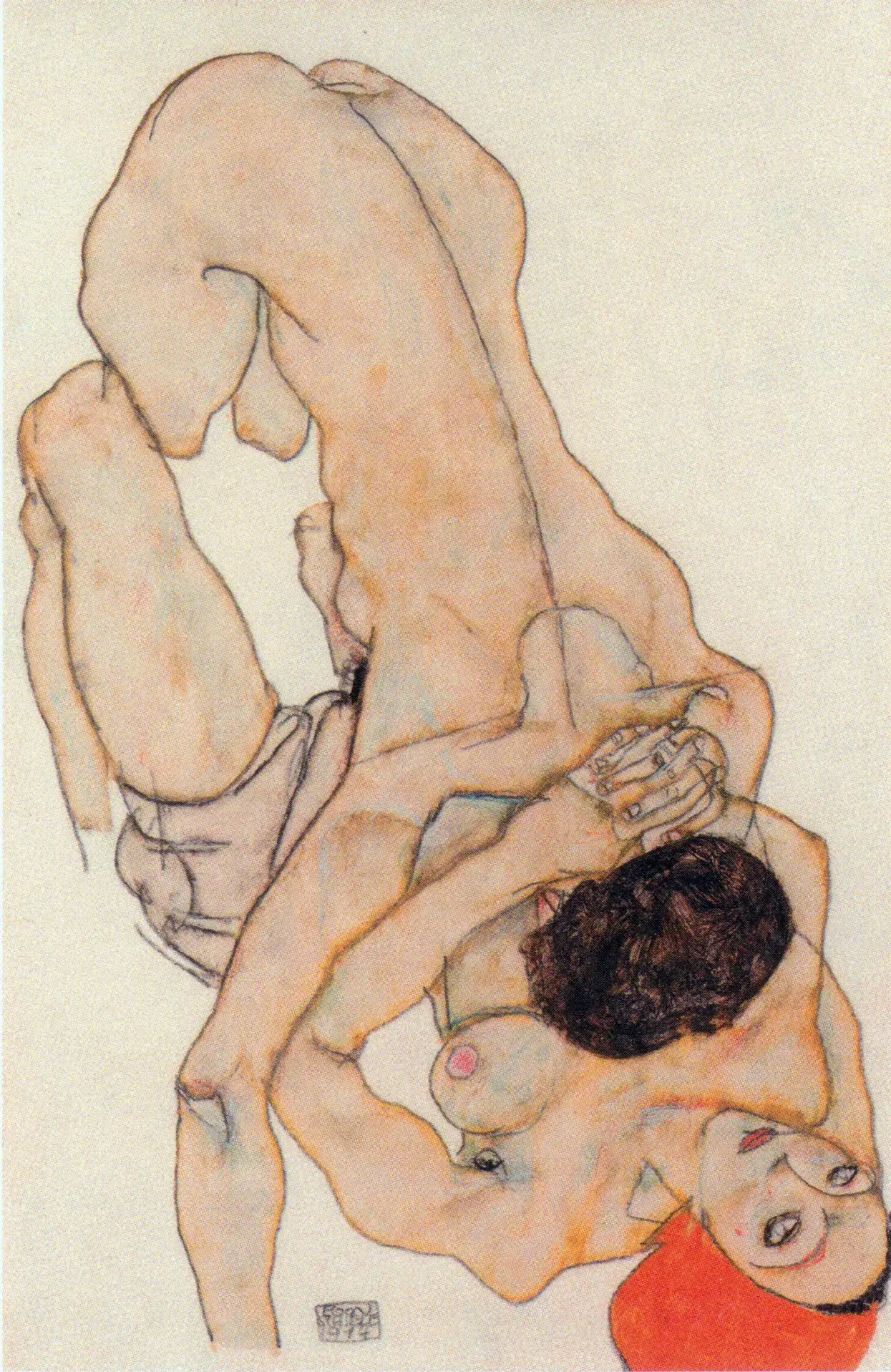
The master of drawing and line.
The German art encyclopedia, Thieme and Becker, qualifies Schiele as an eroticist because of the erotic portrayal of the human body in his art. In this case, however, it is for him not only a study of feminine but also male nudity, especially his own. His models characterize incredible freedom concerning their own sexuality, self-love, homosexuality, or voyeuristic attitudes, as well as skillful seduction of the viewer.
Vibrant postures, frenetic gestures and delirious gazes are the essence of the work of the Austrian artist Egon Schiele. His nudes were hard and sharp, with cutting and incisive lines, but not only physical: the psychological depth of those portrayed goes beyond any sexuality. The figures are extremely thin with unnatural poses, wild eyes and misshapen hands, writhing in pain or lust.
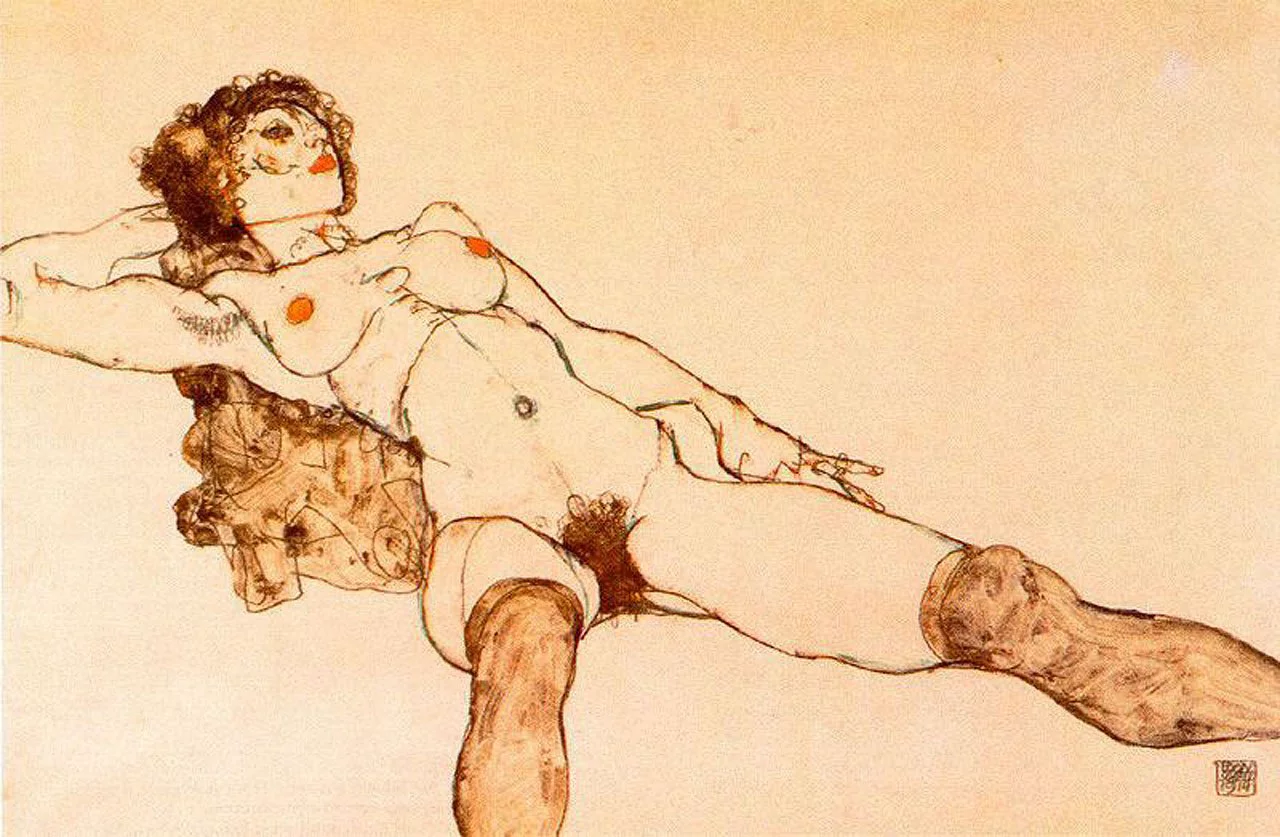

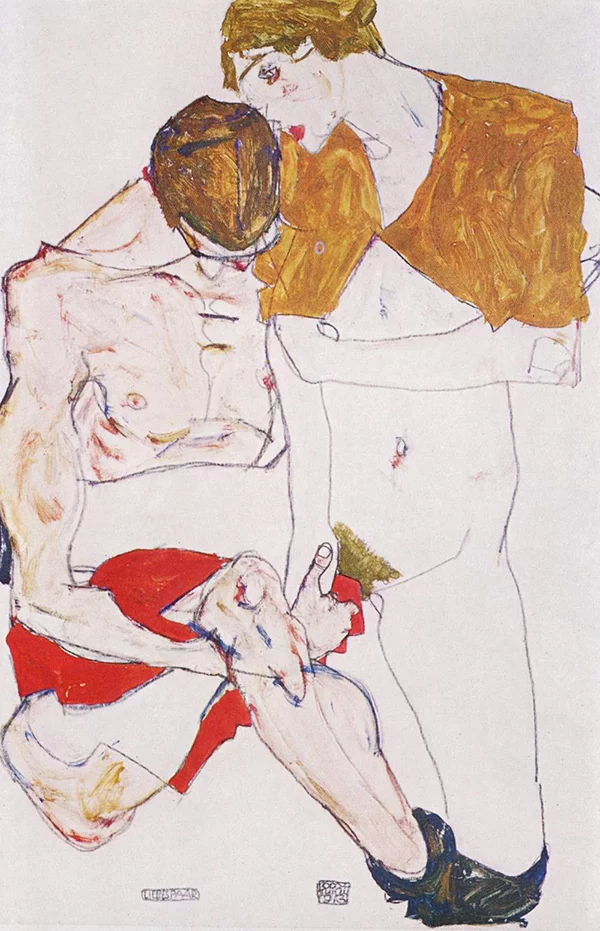


embracing, 1915
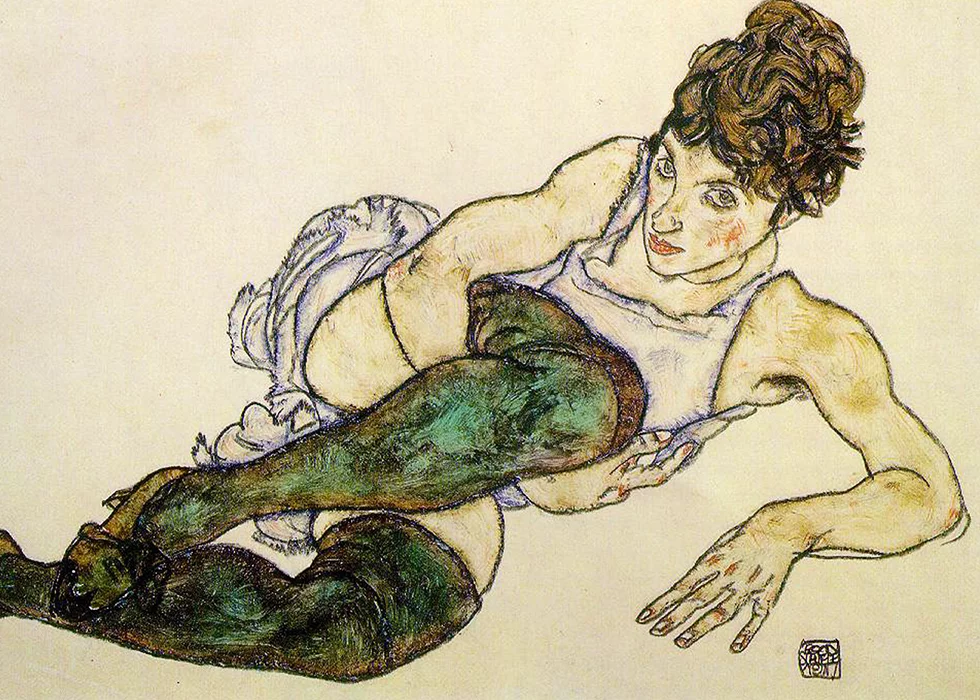
The stereotypical notions of feminine beauty didn't appeal to Schiele. His nude sketches are contours of the body on paper, sometimes sinuous and almost always irregular and angular, since the artist seems to be fascinated by bony structures. He was aware that the urge to look is interconnected with the mechanisms of disgust and allure. The body contains the power of sex and death within itself.
At the core of his creation, Schiele sets the difference from his master: his muses are not those of Klimt. Schiele finds his models on the streets, young girls of the proletariat and prostitutes; he prefers the child-woman androgynous types. Thin, gaunt bodies of his models characterize lower-class status, while full-bosomed, luscious ladies of the bourgeoisie express theirs through well-fed corpulence.
Despite their young age, Schiele’s models are aware of their erotic radiance and skillfully know how to set it into a scene. The masturbating gesture of the hand on the vagina accompanies the provocative gaze of the model. Schiele's drawings speak to simple body consciousness and the matter-of-course attitude with which the lower levels of society, where love for sale pertains to earning one's daily bread, deal with sexuality.
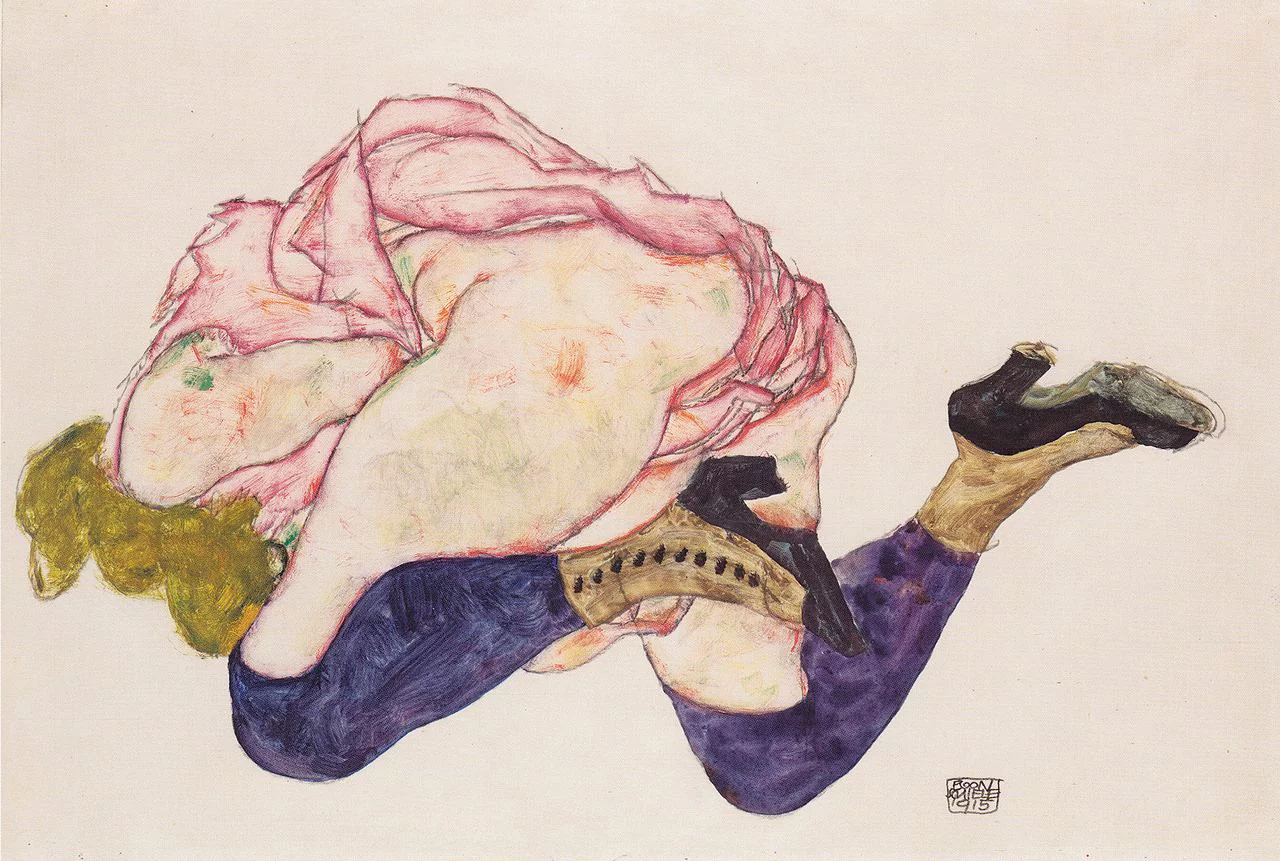
Head Bowed Down, 1915
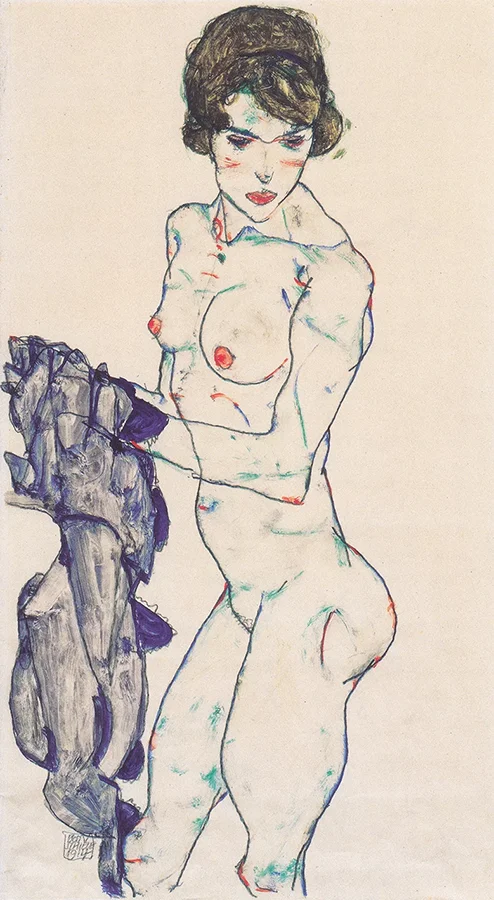

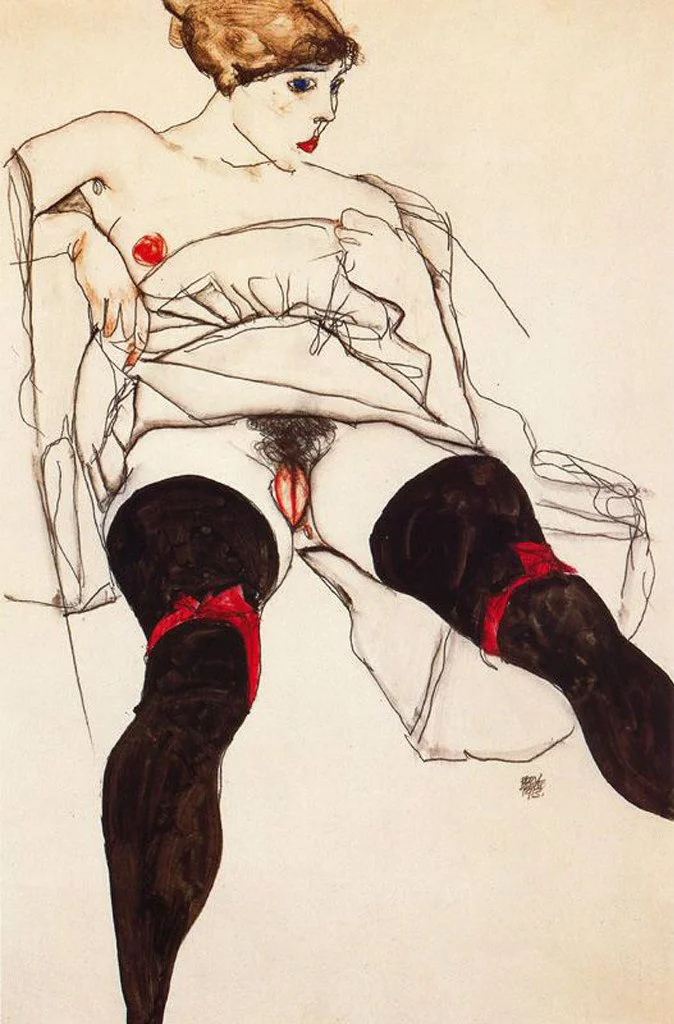
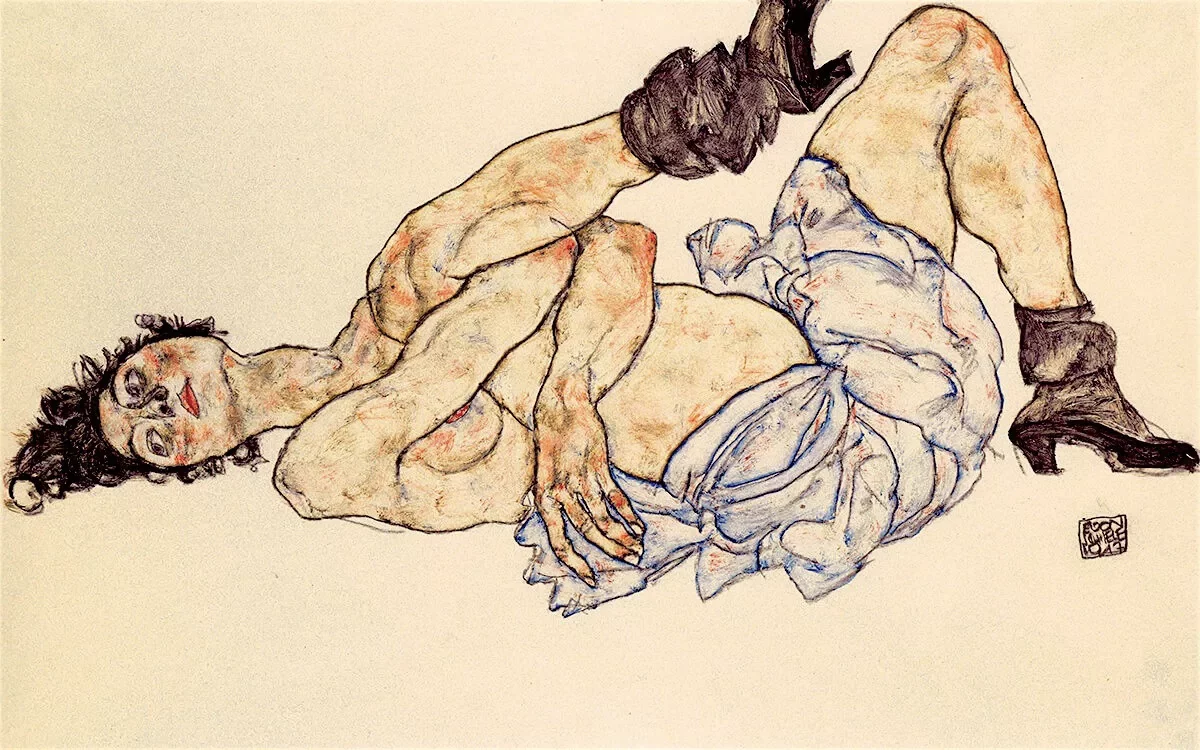
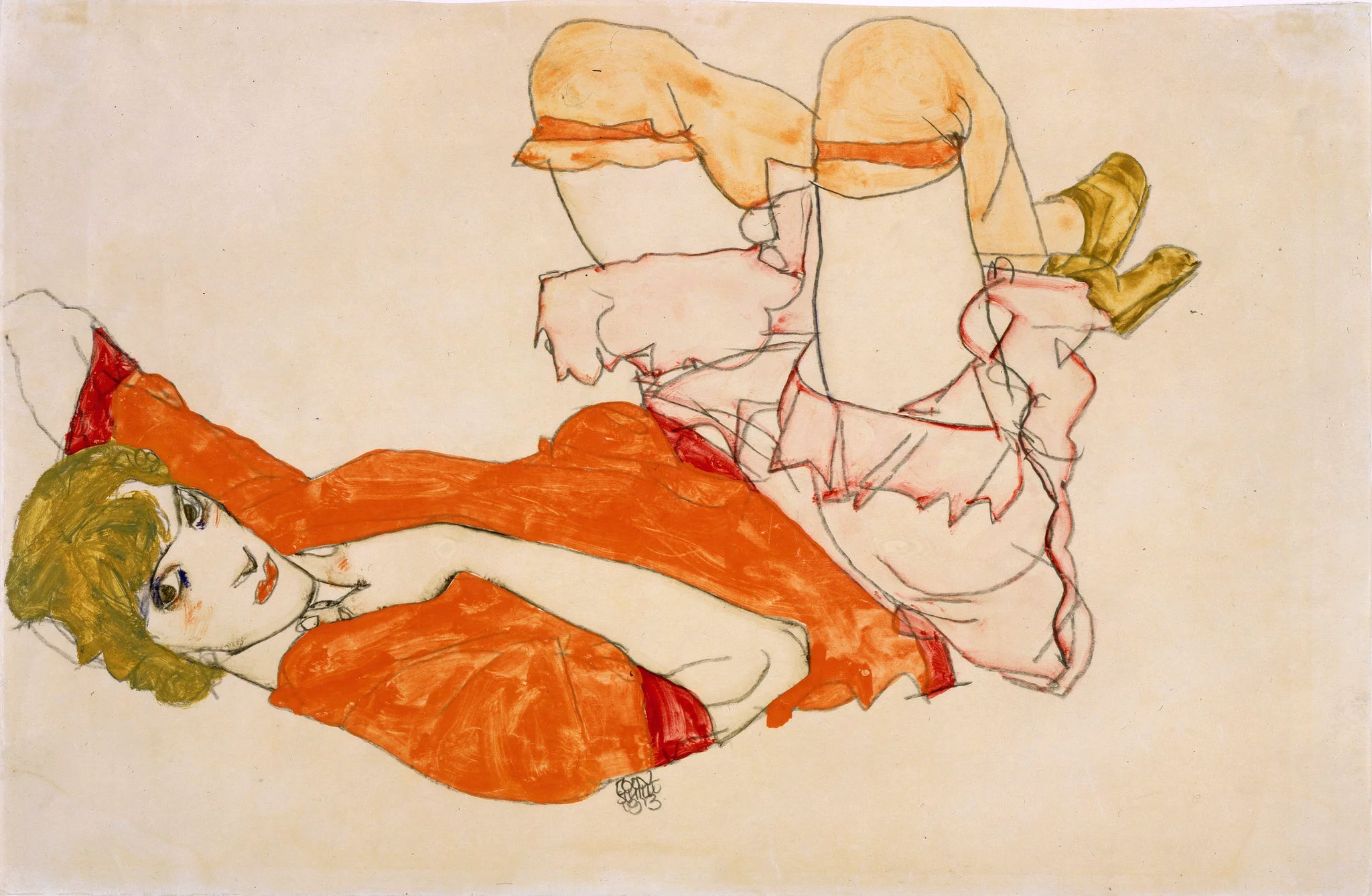
Lyng on Her Back, 1913
HIS FAVOURITE
MODEL: HIMSELF
He regarded the self-portrait as one of his major subjects and showed himself more often than not fully or partially nude.
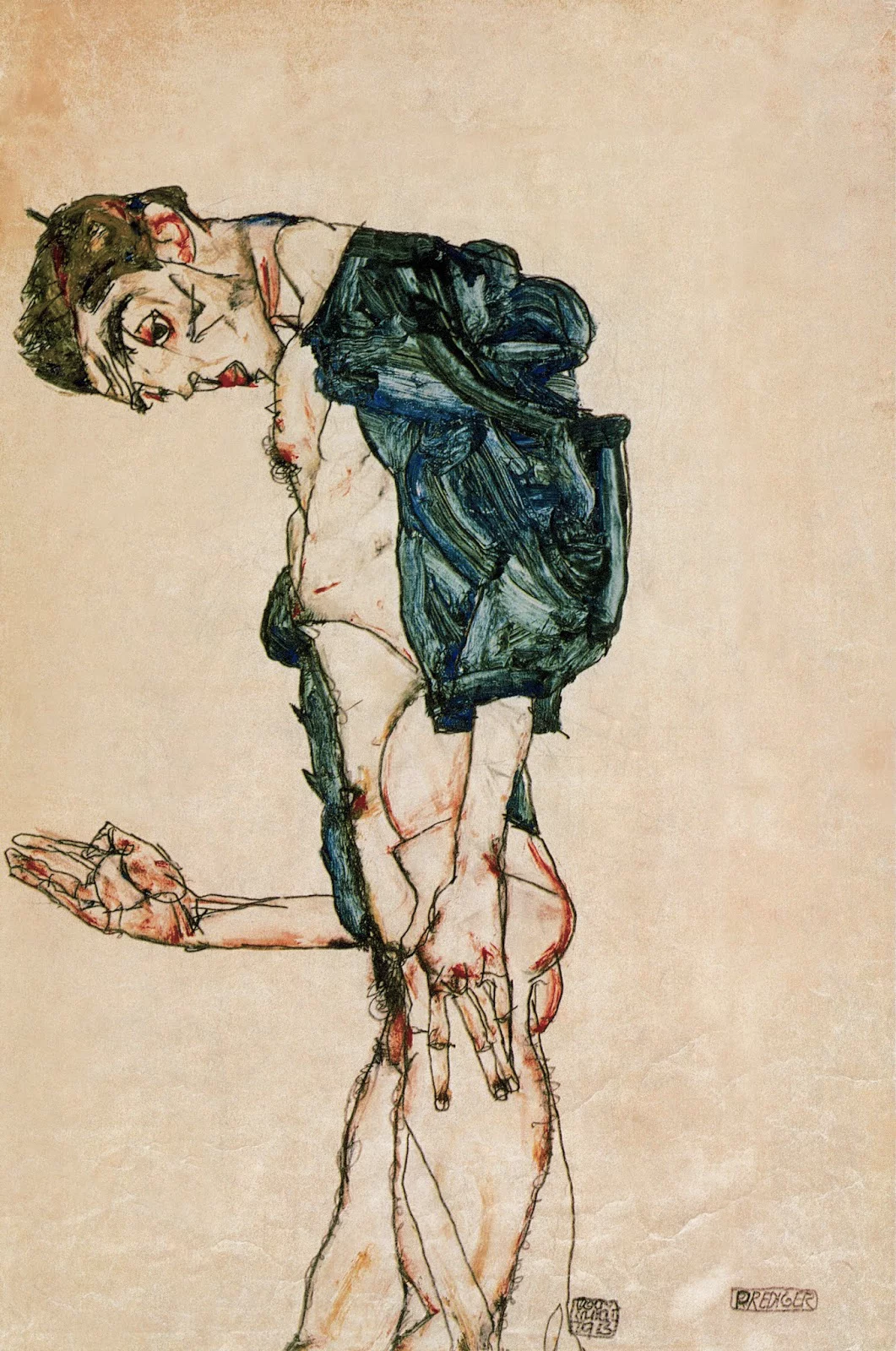
There are approximately 100 self-portraits with several nude studies of Schiele. In many of them he is depicted with an erect penis or directly masturbating, if not in full intercourse, presenting himself in a dilapidated state and sometimes openly showing his psychosexual disorders. For Schiele, it was the best way of exploring and exhibiting himself.
His nude studies depicting the rigid member, masturbating, go a step further and depicts him as a man fascinated by his own sexuality. This reversal in passivity accompanies the setting of a new goal: to be looked at. Moreover, the artist does more than invite us to look at and admire him. He announces that he is the subject of his art, whether directly and obviously in the form of self-portraits or indirectly by making whatever he draws and paints a record of his feelings and ideas.
The discrepancy between Schiele’s external appearance and his repulsively ugly self-portraits is astonishing. Gütersloh describes Schiele as “exceptionally handsome”, an elegant young man, whose good manners strangely contrasted his reputedly unpalatable manner of painting. Schiele, on the other hand, paints himself with a long skull-like face. 'Alles ist lebend tot,' he once wrote - everything is both living and dead.


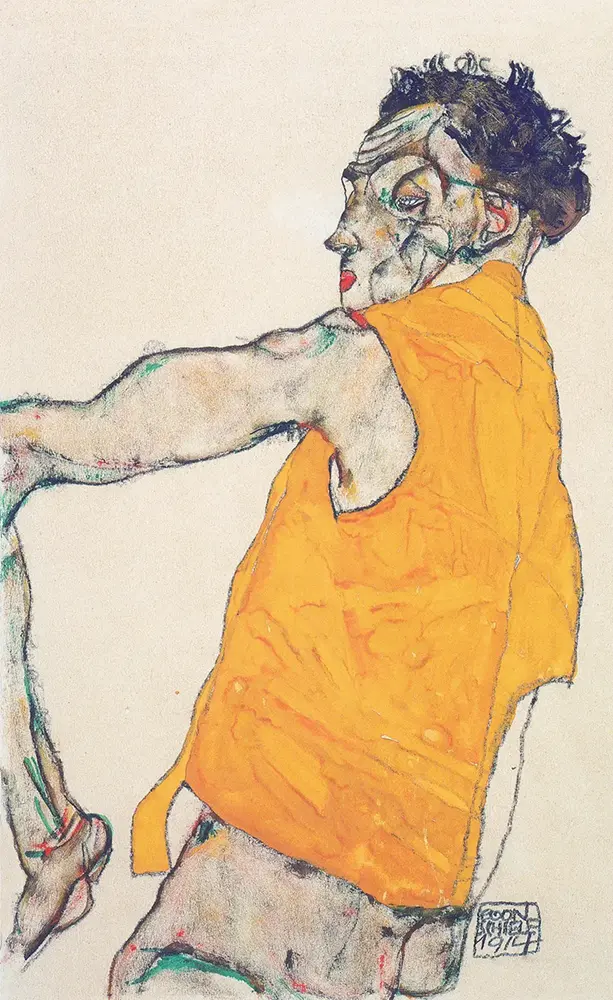


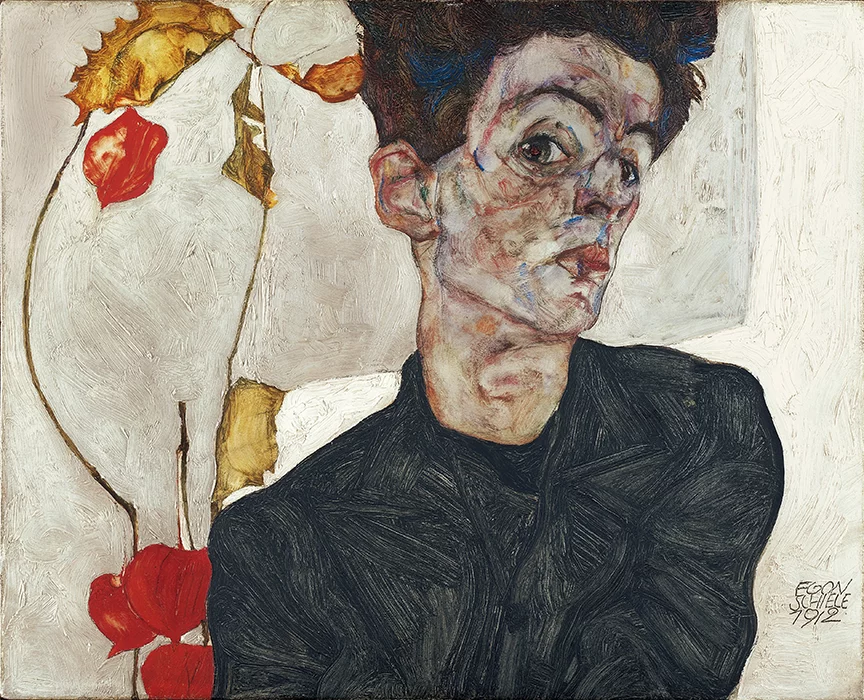

All beautiful and noble qualities have been united in me. . . I shall be the fruit which will leave eternal vitality behind even after its decay.
March 1913
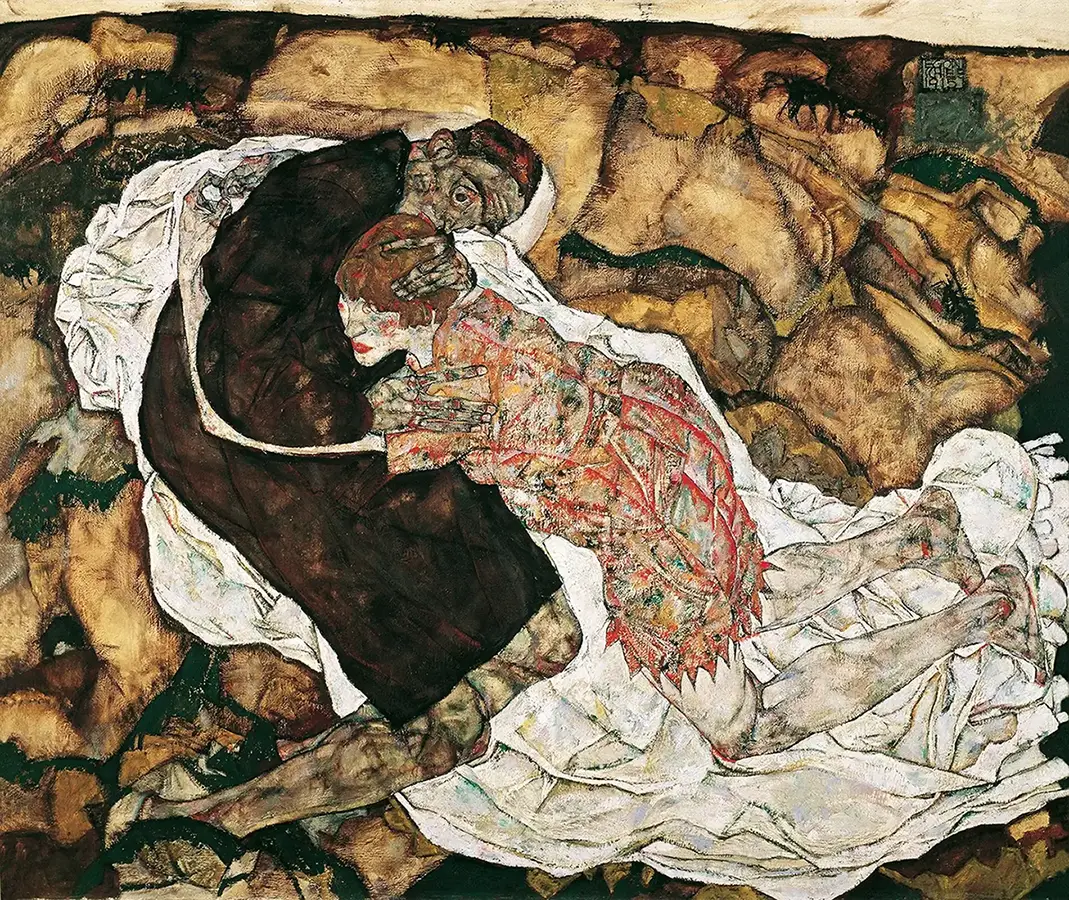
LOVE,
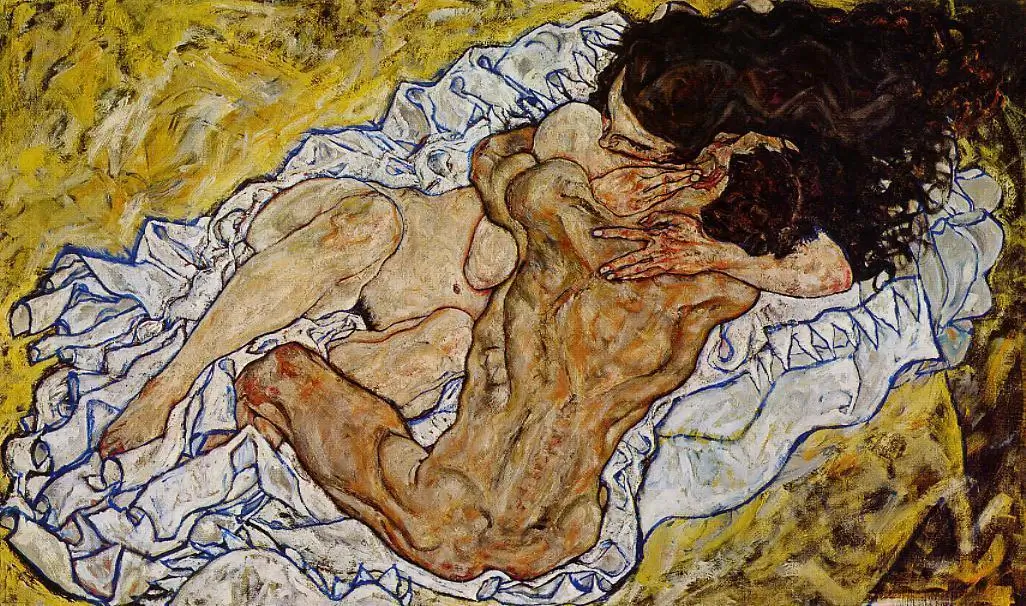
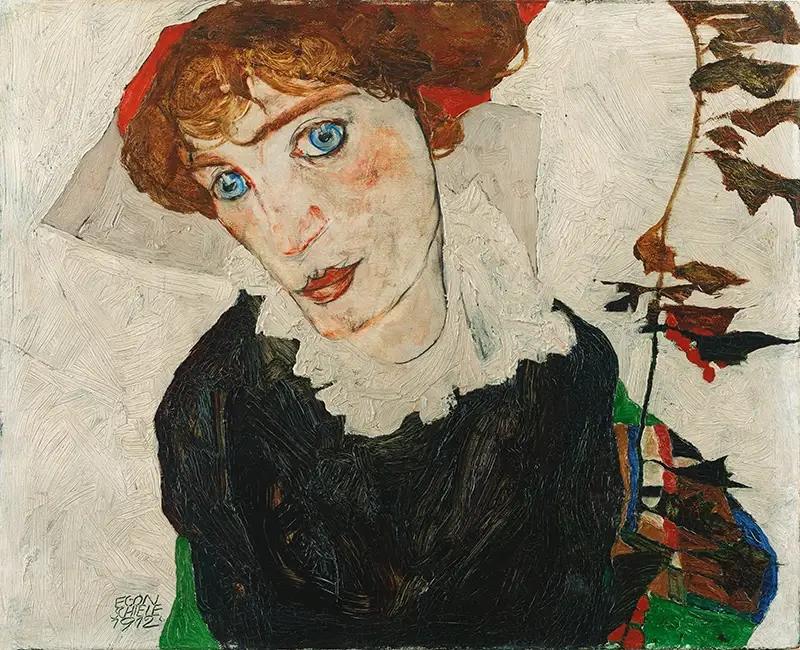
wally neuzil, 1912

Egon Schiele's portraits prior to his relationship with Walburga Neuzil, or Wally, were often marked by an overt eroticism, but lacked a deeper psychological insight or representation of love. However, Wally's presence in Schiele's life had a profound impact on his art, and her influence can be seen in his later works. These paintings and drawings are more intimate and reveal Wally as a real woman rather than simply an object of desire.
THEMES
DEATH & FAMILY
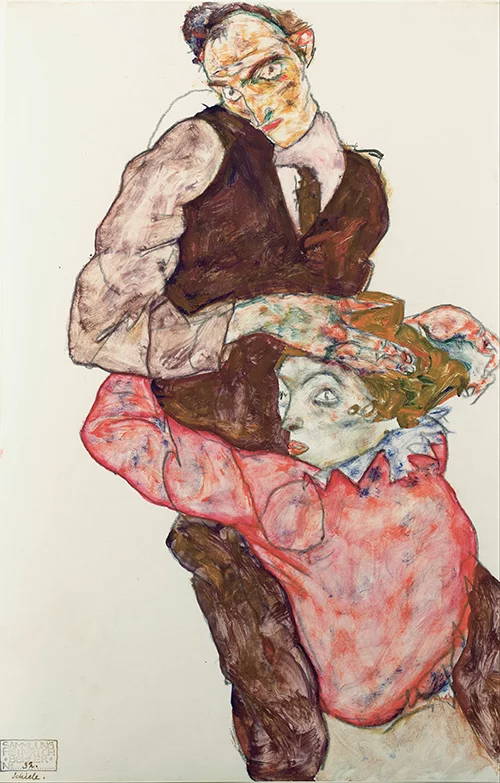
How good! Everything is living dead.
Schiele never ceased to be fascinated by decline and decay, whether registered in the faces and bodies of human beings or the autumnal configurations of natural things. His paintings and drawings often dramatize the mortality of everything. Even at the moment of its greatest perfection and glory, a flower has begun to decay. Schiele's landscapes—often devoid of people— and still life work too reflect his fascination with death.
In the clinic of the gynecologist Erwin von Graf, he studies and draws sick and pregnant women and pictures of new and stillborn infants. Schiele is “...astonished, he saw unusual changes in the skin, in whose sagging vessels thin, watery blood and tainted fluids trickled sluggishly, he marveled also at light-sensitive green eyes behind red lids, the slimy mouths and the soul in these unsound vessels”, reports Roesseler.

fuchsias, 1909

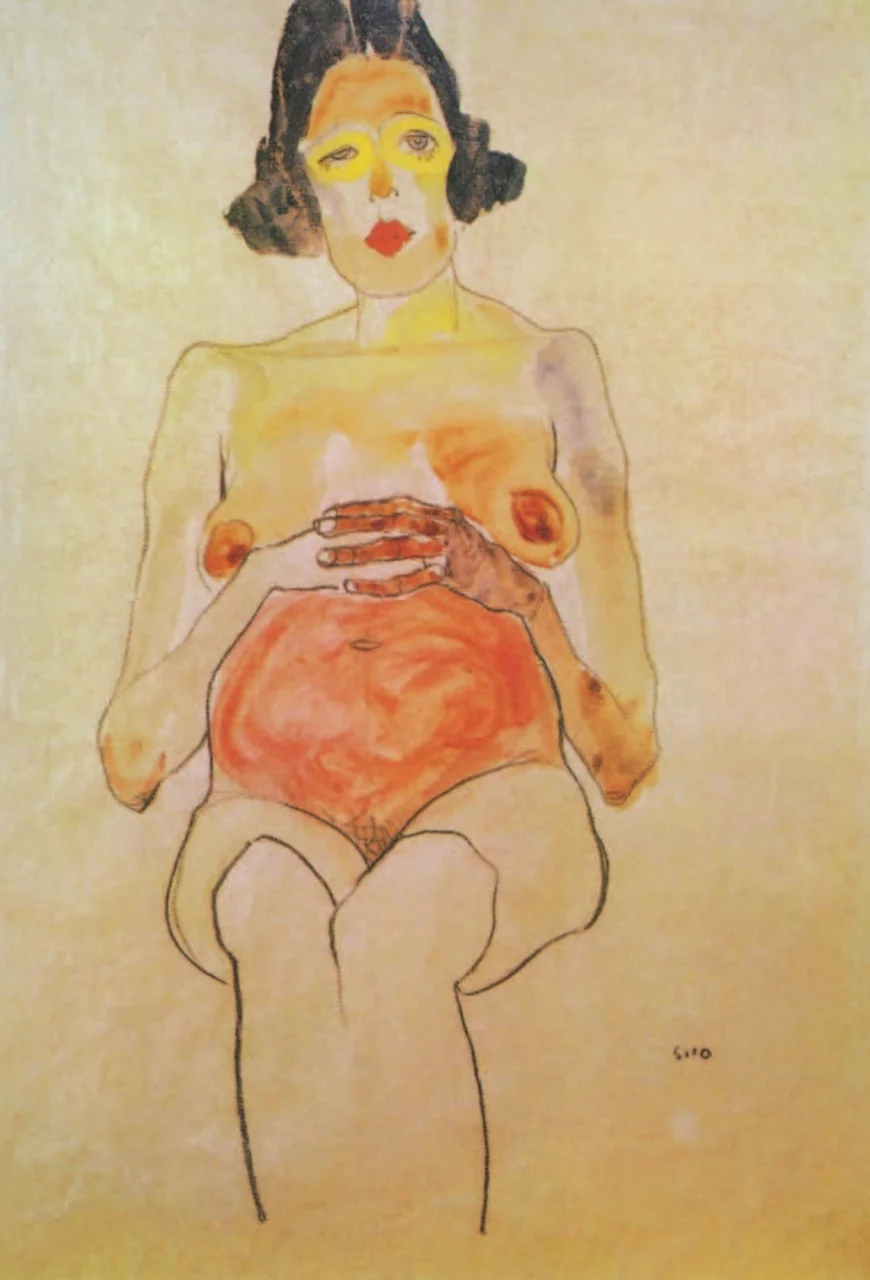
Egon Schiele's exploration of motherhood in his art is particularly poignant in his "Dead Mother" series of paintings from 1910-11. Reflecting his own complex and troubled relationship with his mother, Schiele repeatedly returned to the theme of motherhood throughout his career, culminating in his 1915 work "Mother with Two Children."
In the "Dead Mother" series, Schiele subverts traditional notions of nurturing and caregiving by depicting the mother figure as one who is giving death rather than life. The child in these paintings, often Schiele himself, is portrayed as experiencing separation from an overbearing and engulfing mother, represented by the progressive physical distance and growing autonomy of the child in each painting.

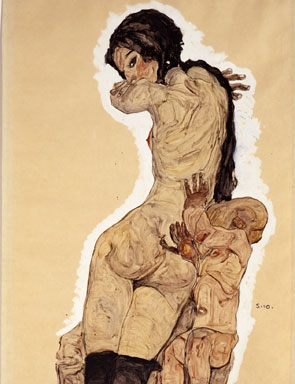
homunculus, 1910
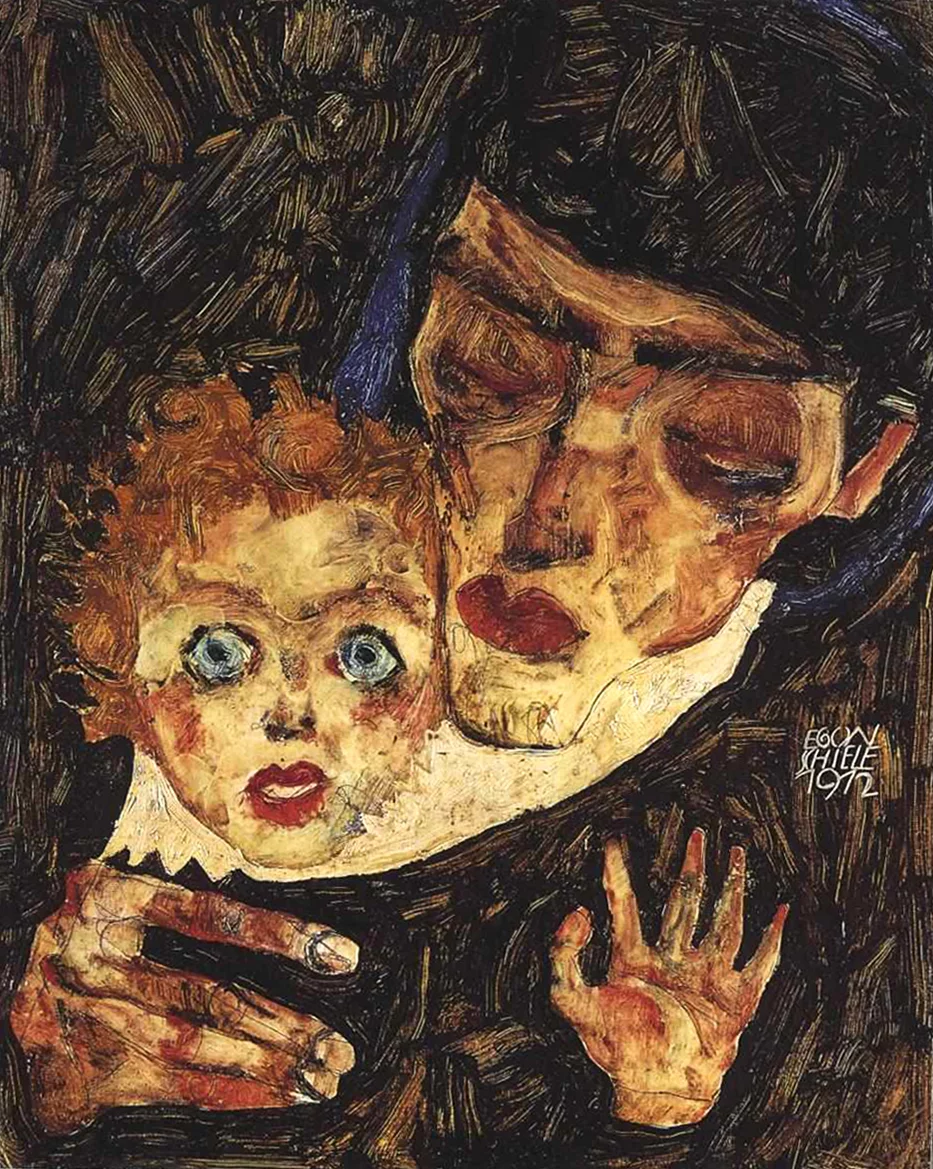
My mother was the one who was most present in my early drawings. She was the most beautiful apparition in my childhood, and she remained so until the end.
critic Arthur Roessler
Egon Schiele's later works reveal a significant shift in his artistic style, with softer lines and a greater sense of tenderness and care.

In contrast to his earlier paintings, which often portrayed intimacy as murderous and violent, Schiele's later works showcase a transformation in his self-expression. This is perhaps reflective of Schiele's own personal growth, as he embraced the role of husband and, later, father.
The figures in his paintings connect with each other on a deeper, more meaningful level, showcasing Schiele's growth as an artist and as an individual.It's possible that Schiele's personal life played a role in this shift. Inspired by his sister's pregnancy and his own marriage to Edith Harms in 1915, Schiele's eroticism became less violent and more focused on themes of balance, nature, and nurture. His experimentation with the theme of motherhood and family is evident in many of his later works, showcasing his evolution as an artist and his embrace of a more compassionate perspective.


